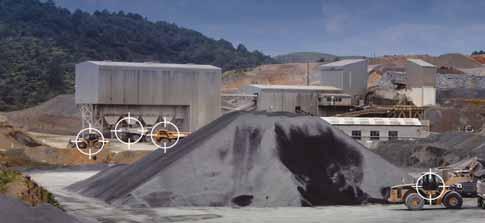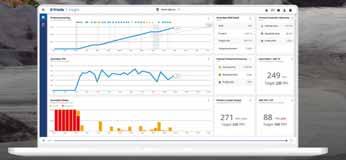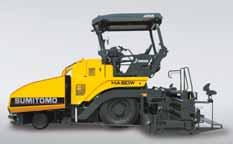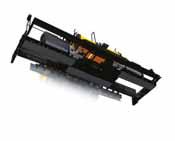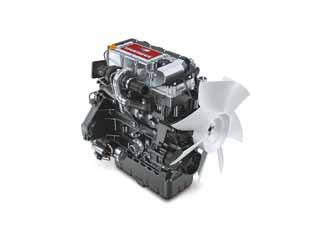



































































































In construction, the challenges are constant. We’re committed to helping you find the right solutions as you work toward sustainability in achieving environmental and business goals.
Over the last decade, we have reduced CO2 emissions by 30 to 45% on some of our core construction products. Over a year, this means those machines now emit about 20 to 30 metric tons less CO2 * And, this is just one of the ways we’re working to help you make your job sites more sustainable and profitable.
Wherever you are on your sustainability journey, we’re ready to help. Contact us today or visit Cat.com/Sustainable-Choices

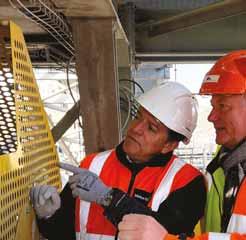
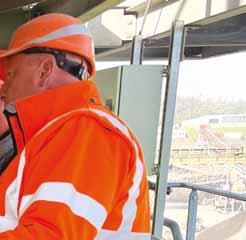


“The Metso Outotec HRC 8 high-pressure roll crusher eliminates the problem of a high-speed rotor generating very high energy and repair costs and unscheduled downtime”

04 COMMENT
Big industry themes going into 2023
06 NEWS
Cement industry talks decarbonisation; Aggregate Industries’ ‘industry-first’ carbonreporting tool; Breedon Group on track to deliver record annual earnings
14 ASSOCIATION NEWS
Gaspard Van Goethem, UEPG’s (European Aggregates Association) new public affairs officer, considers the European Commissionproposed Nature Restoration Law
16 LEGAL UPDATE
James Rickard and Laura Stanley discuss the key legal considerations to bear in mind for anyone looking to set up a new company in the UK with another person or people
50 EQUIPMENT UPDATE
Global quarrying equipment manufacturers’ new model launches and applications
51 EVENTS
All the key events in the quarrying & aggregates world
October’s bauma show saw a host of new crushing and screening plant launches from the major manufacturers
22 LOADING
Electric prototypes, a new generation of large excavators, and a major equipment manufacturer making its debut in the European wheeled loader market
25 HAULING
Advanced testing of driverless articulated dump trucks (ADTs) and the growing presence of 4x4 ADTs are key talking points in the global offhighway hauler market
30
Washing plants are a crucial and evolving element of the production of high-quality aggregates and sands
33
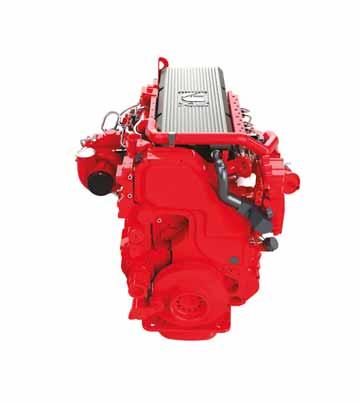
With materials costs rising and resources depleting, regulations are calling for the adoption of sustainable solutions and recycling of construction waste
35
Atlas Copco’s Barbara Gregorio discusses how portable power solutions are part of a wider solutions portfolio helping to achieve more sustainable quarries
39
Leading off-highway engine manufacturers have made sustainability a priority alongside the renowned high performance and efficiency of their solutions























COVER STORY: A BiA-supplied Metso Outotec HRC 8 high-pressure roll crusher is boosting Carriére des Limites’ production of high-quality manufactured sand
08 INTERVIEW
Dr Edelio Bermejo, Holcim’s global head of R&D and IP, heads an extensive global and gifted team working daily on new, greener building materials that can drive down the global construction industry’s carbon footprint
43 MARKET REPORT
The Eastern European aggregates industry has experienced a very challenging time, with severe COVID-19-induced disruption followed more recently by the fallout of Russia’s war with Ukraine
47 QUARRY PROFILE



The first European installation of a Metso Outotec HRC 8 high-pressure roll crusher is helping a leading Belgian quarrying company produce high-quality manufactured sand for its customers













HEAD OFFICE
EDITOR: Guy Woodford
ASSISTANT EDITOR: Liam McLoughlin
CONTRIBUTING EDITORS: Patrick Smith, Dan Gilkes
EQUIPMENT EDITOR: Mike Woof
DESIGNERS: Simon Ward, Andy Taylder
PRODUCTION MANAGER: Nick Bond
OFFICE MANAGER: Kelly Thompson
CIRCULATION & DATABASE MANAGER: Charmaine Douglas
INTERNET, IT & DATA SERVICES DIRECTOR: James Howard




WEB ADMINISTRATORS: Sarah Biswell, Tatyana Mechkarova
MANAGING DIRECTOR: Andrew Barriball
PUBLISHER: Geoff Hadwick
CHAIRMAN: Roger Adshead
ADDRESS

Route One Publishing Ltd, Second Floor, West Hill House, West Hill, Dartford, Kent, DA1 2EU, UK
TEL: +44 (0) 1322 612055








During what has been a very busy schedule of autumn work travel, including a great week at bauma 2022 in Munich, several key themes have emerged in my conversations with quarry operators and quarry machinery manufacturers. Time and again the increased automation and digitilisation of aggregates production, cost control amid sky-high energy costs, alternative plant fuel options, and how best to optimise whole-operation sustainability would dominate discussion.
On the last of those topics, I think one major company’s very interesting development in the global building materials supply sector will be mirrored not just by other large and smaller sector players, but by the world’s quarrying and heavy construction equipment manufacturers.
CEMEX has signed an agreement with BBVA Mexico to offer preferential rates under its supply-chain finance programme to suppliers that demonstrate the best environmental, social, and corporate governance (ESG) practices.
As part of this agreement, a revolving line of MXN 1,600mn (€79.2mn) was made available to approximately 3,000 CEMEX suppliers, which can now finance their working capital at preferential rates.
Suppliers seeking to access this benefit will be evaluated by a third party to ensure that they meet the ISO 26000 standard, a social responsibility guide for public and private entities encompassing human rights, labour practices, the environment, fair operating practices, and active participation in community development. Supply-chain finance operations will be carried out through the eFactor Network platform, a leading fintech company in working capital financing.
This programme is a step forward in CEMEX’s goal of evaluating sustainable practices in at least 80% of its critical suppliers by 2025 and 90% by 2030.
My week at bauma 2022 was full of news about and walking tours around new crushing, screening, loading and hauling equipment unveiled by many of the top names in the world’s quarrying machine industry. Inside this edition of Aggregates Business Europe, you’ll read about some of the new products that I saw and hear from the senior executives who masterminded their market launch.
Before heading off to Munich, I spent a week in Northern Ireland visiting the many top quarrying equipment manufacturers based there. Those that follow both my personal and the Aggregates Business LinkedIn platforms will have seen many pictures and headline news from my trip, with more detailed reports on some of the OEMs (original equipment manufacturers) flagging up new plant installations and manufacturing and assembly capability enhancements set to feature in forthcoming issues.
Another enjoyable trip was to Portugal with Caterpillar, where I saw how a Cat 980BH (block handler) is proving a crucial machinefleet gain for a successful marble quarry operation in the south of the country. A full and exclusive report on my visit will appear in ABE’s Jan-Feb 2023 edition.
You will be reading this column after I have made two other big work trips. The first was a four-day trip to Finland to see Metso Outotec, Allu and Robit and some of their Finnish quarrying customers. The second trip took me to Brussels for an exciting night celebrating the winners of the UEPG Sustainable Development Awards 2022. For the second time, I was delighted to be part of the judging panel for the awards, which attracted a wealth of high-quality entries from large and small- to medium-sized aggregates business operators from all over Europe.
The awards night reaffirmed what I already knew: that the European aggregates industry remains vibrant and keen to achieve a more sustainable future. GW
FAX: +44 (0) 1322 788063
EMAIL: [initialsurname]@ropl.com (psmith@ropl.com)
ADVERTISEMENT SALES
SALES DIRECTOR: Philip Woodgate TEL: +44 (0) 1322 612067
EMAIL: pwoodgate@ropl.com
Dan Emmerson TEL: +44 (0) 1322 612068
EMAIL: demmerson@ropl.com
Graeme McQueen TEL: +44 (0) 1322 612069
EMAIL: gmcqueen@ropl.com
SUBSCRIPTION / READER ENQUIRY SERVICE
Aggregates Business is available on subscription at the rate of: £85 / US$145 / €111 per annum. Single copies £20 / US$35 / €26
Email subs@ropl.com for further details.
Subscription records are maintained at Route One Publishing Ltd.
SUBSCRIPTION / READER ENQUIRIES TO:
Data, Route One Publishing Ltd, Second Floor, West Hill House, West Hill, Dartford, Kent, DA1 2EU, UK
TEL: +44 (0) 1322 612061 FAX: +44 (0) 1322 788063
EMAIL: data@ropl.com

No part of this publication may be reproduced in any form whatsoever without the express written permission of the publisher. Contributors are encouraged to express their personal and professional opinions in this publication, and accordingly views expressed herein are not necessarily the views of Route One Publishing Ltd. From time to time statements and claims are made by the manufacturers and their representatives in respect of their products and services. Whilst reasonable steps are taken to check their accuracy at the time of going to press, the publisher cannot be held liable for their validity and accuracy.
PUBLISHED BY © Route One Publishing Ltd 2022
AGGREGATES BUSINESS USPS: is published six times a year. Airfreight and mailing in the USA by agent named World Container Inc, 150-15, 183rd Street, Jamaica, NY 11413, USA.
PERIODICALS POSTAGE PAID AT BROOKLYN, NY 11256 US POSTMASTER: Send address changes to Aggregates Business, World Container Inc, 150-15, 183rd Street, Jamaica, NY 11413, USA. Air Business Ltd is acting as our mailing agent
PRINT: ISSN 2051-5766
ONLINE: ISSN 2057-3405
PRINTED BY: Warners (Midlands) PLC
Facebook @AggBusiness
LinkedIn Aggregates Business Magazine
Twitter @Agg_Business
Instagram @aggbusiness_magazine










You’re in control of your business with the new range of Hitachi wheel loaders. They will improve your profit thanks to exceptional fuel economy and efficiency, as well as outstanding uptime and ultra-reliable performance. Make your vision a reality with ZW-7.



Aggregate Industries has launched what it says is the building materials industry’s first carbon-reporting tool to offer customers accurate carbon data by product or project. The company adds that the customisable reporting tool produces a report using data from across its business areas to provide a comprehensive cradle-to-site assessment. The tool looks at the whole manufacturing process, from raw material extraction to transportation, to provide a full and accurate carbon assessment of the products. The report can be generated quickly, from request to supply, and allows Aggregates Industries’ customers the flexibility to interrogate the data to identify where future carbonsavings can be made. To give assurance to customers that the solution includes all necessary material flows and is in line with industry best practice, all data in the carbon reporting tool is independently audited by Circular Ecology. Kirstin McCarthy, sustainability director at Aggregate Industries, says: “Our research shows us that low carbon is the most important area of sustainability for our customers. We’re seeing an increasing number of whole-year data requests to set a baseline to reduce CO2 To date, this has always been done manually using various product carbon-footprinting tools and generic databases.
“In response, we wanted to develop an automated system, increase accuracy and meet the growing demand, while also providing customers with an audit trail for complete transparency. Our new tool, Your Carbon Report, offers exactly this – and we believe it is an industry first.”

On 10-11 November, the CarbonZero Global Conference and Exhibition brought together a large array of leading experts to find and outline the most effective solutions for decarbonising the global cement industry, which is responsible for almost 8% of the world’s CO2 emissions.
The topics that make the agenda of the biggest cement and other building materials companies worldwide and the latest developments and challenges in product manufacturing and technology applications were discussed at this one-of-a-kind forum on Alternative Fuels and Raw Materials at Pestana Palace Hotel & National Monument, Lisbon.
One of the conference’s main conclusions is that these troubled present times require clear policies and instruments for a clean and safe future. It’s time


for the whole industry to move from “we need to...” to concrete steps to ensure the decarbonisation of cement and concrete based on alternative fuels and raw materials. The circular economy is a real thing the industry should tend towards. And today’s waste should be turned into tomorrow’s raw material.
One of the largest cement producers in Latin America, Cementos Argos, included for the seventh consecutive year in the Dow Jones Global Sustainability Index (DJSI) as one of the most sustainable companies in the world, was represented by Mauricio Giraldo, alternative fuels director, and Edgar Martinez, senior sustainability director. The conference delegates were presented with the company’s successful practices and steps they take for decarbonisation.
Dr. Edelio Bermejo, head of group R&D and IP at Holcim,


explained the way Holcim dedicates more than 80% of its innovation resources to developing sustainable products and solutions. It recently launched ECOPlanet, its global range of green cement, delivering at least a 30% lower carbon footprint with equal-tosuperior performance.
Heidelberg Materials, represented by Jan Skocek, head of Global R&D, explained technological advances the company has made to enable the 100% recycling of concrete by reusing all constituents back in the original materials.
Senior executives from Dalmia Cement, Titan Cement, Cimpor, Cement & Concrete SA, KHD, Firefly AB, Bedeschi, KEO International Consultants, MedCem Global, ABREN, and SpectraFlow Analytics were among other speakers at the two-day gathering.
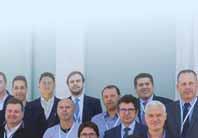

Breedon, a major independent construction materials group in Great Britain and Ireland, says it is on course to deliver record annual earnings.
In the four months to 31 October 2022, Breedon delivered revenue growth of 16% compared to the same period in 2021. This resulted
in group revenue of £1,186mn from 1 January - 31 October 2022, some 14% ahead of the equivalent ten months last year and 12% on a like-for-like basis. A group statement says trading conditions during the second half remained supportive, enabling the group to fully recover rising input costs through
robust pricing and disciplined cost management.
While the Breedon on the Hill, Derbyshire, England-headquartered group’s volumes are behind the exceptional levels recorded during the post-COVID recovery in 2021, they remain ahead of 2019 on a like-for-like basis.


Offering more power with less complexity and less weight. This engine delivers the productivity you need to keep your equipment running. Proven in a wide range of industrial applications, its power increases to 326 hp / 243 kW enabling replacement of engines with higher displacement with no impact on productivity.





Visit us at ConExpo 2023, Booth S84615.
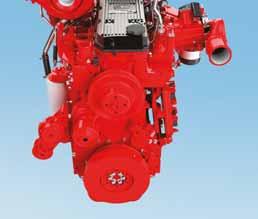
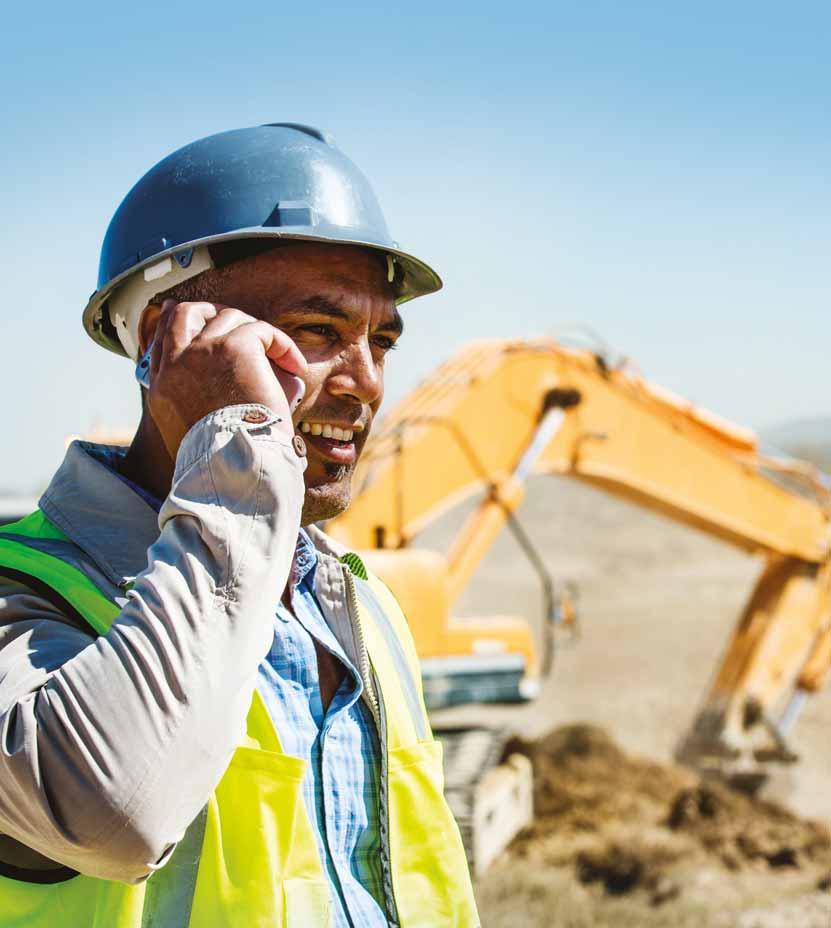














Dr Edelio Bermejo is Holcim’s global head of research and development (R&D) and intellectual property (IP). He oversees a large and highly gifted team based in different parts of the world which works daily on new, greener building materials that can drive down the global construction industry’s significant carbon footprint. Aggregates Business editor Guy Woodford spoke to him about his vital work




The cement and construction industries are among the highest CO2 emissions generators in the world. The cement industry alone accounts for 8% of global emissions, not far behind the agriculture industry with 12%. Given that context, it is not surprising on our Teams call that Dr Edelio Bermejo is keen to articulate the importance of discovering and utilising greener building materials if the cement and concrete industry is to achieve its ambitious goal of net-zero concrete by 2050.
“When you look at global population growth, there will be around 2.5 billion more people on our planet by 2050, 80% of which will be living in urban areas that will be built up vertically and horizontally. Two-thirds of the infrastructure required by 2050 is not yet built. Concrete will be in high demand, and as we emit CO2, we have no choice but to decarbonise it and go for net zero. We need to rethink how we design every building or other structure and reduce the amount of material going into it without reducing its final quality. It is also important not to lose sight of the present. Today, the equivalent of a New York City is built every month!”
Bermejo stresses that as the global cement and concrete industry gets nearer its 2050 net-zero goal, it will need a lot of financial assistance from governments and other bodies, such as the World Bank and the IMF (International Monetary Fund), to build and maintain the required infrastructure to store and utilise the captured CO2

“Guys, just trust us, and by 2050 you will get zero-emission cement”
When asked about the role of China, by far the biggest producer of concrete and cement, within the global industry’s efforts to decarbonise by 2050, Bermejo responds: “When China decides there is no other way to produce concrete and cement without decarbonising it, they will do it. In 2008, they decided there were too many cement players – around 2,000. They were emitting a lot of carbon. The Chinese government then said, ‘In four years, I only want 200 companies left operating. The rest will be closed’.
“What happened was that the very old plants were closed, and then the larger players bought the smaller ones and invested in new, greener production technologies. As a result, they have made a huge improvement in reducing their CO2 emissions.”
Aggregates Business recently reported on Holcim’s launch of the world’s first 1.5°C science-based framework to decarbonise the cement industry, resulting from its partnership with the Science Based Targets initiative (SBTi). This 2030 targeting framework was independently developed by the SBTi, in collaboration with an expert advisory group representing academia, civil society and industry to decarbonise cement in a rigorous and science-driven way. The Net-Zero Standard offers companies robust certification to demonstrate to consumers, investors and regulators that their net-zero targets are reducing emissions at the pace and scale required to keep global warming to 1.5°C.
The recent launch of Holcim’s SBTivalidated landmark framework could not have
been better timed for Bermejo, a SpanishFrench dual national, given his key speaker engagement at CarbonZero: Alternative Fuels and Raw Materials 2022 on November 10 and 11. Featuring a conference and exhibition, the event was held at the Pestana Palace Hotel & National Monument in Lisbon, Portugal, focusing on topics that make the agenda of the biggest cement and construction companies worldwide.
Highlighting the overall theme of the conference, Breaking old habits and patterns, Bermejo, who is based at Holcim’s stateof-the-art R&D headquarters in Lyon, France, talked about Holcim’s strategy for decarbonising the cement industry. Holcim dedicates more than 80% of its innovation resources to developing sustainable products and solutions. The group’s 2020-launched ECOPact range of green concrete is proving popular worldwide, and its recently launched ECOPlanet range of green cement is said to deliver at least a 30% lower carbon footprint with equal-to-superior performance. Holcim plans to produce 100 million tonnes of recycled materials by 2030 and utilise technologies like 3D printing that use 70% fewer materials without compromising performance. The group has further across value chain net zero by 2050 targets.
“I am very honoured to speak at this conference and to show that Holcim is the world leader in this area. It is a fantastic opportunity to focus on two key decarbonisation topics – alternative fuels and alternative raw materials. You need to
focus on them simultaneously and in the presence of senior representatives from large as well as smaller- to medium-sized industry companies,” says Bermejo. “The entire industry needs to move on this.”
Holding a PhD in Materials Science, Bermejo has 27 years of experience in product development, marketing, and operations in the cement industry. As Holcim’s global head of R&D & IP, a role he has been in for the past three-and-a-half years, his primary responsibility is accelerating the time to market of existing R&D projects and fostering a more visible innovation culture and external partnerships around new ideas and business models, such as the decarbonisation of the construction industry.
“The industry’s decarbonisation started decades ago and involved all key players. This has meant using alternative fuels, reducing the clinker factor, and leveraging the use of cementitious materials, including slag, pozzolana, and fly ash, across all geographies. What has not been developed enough is the use of alternative [building] materials. Our net 2021 CO2 emissions were 553kg of CO2 per tonne of cementitious material. We are on track to meet our 2030 target of 475kg of CO2 per tonne of cementitious material. We insisted on having interim targets. Otherwise, you are at risk of saying, ‘Guys, just trust us, and by 2050 you will get zero-emission cement’.
“As important as decarbonising our industry is making it circular, with very clear goals. From Holcim’s perspective, it means moving from 54 million tonnes of recycled materials used [in cement production] in 2021 to 100 million tonnes by 2030.”
Bermejo says Holcim’s 15,000m² Lyon R&D facility includes 210 fixed-post researchers, plus some internships, who are supported by a network of R&D colleagues based in Switzerland, Austria, China, and Mexico. “We have a centralised R&D operation, but when it comes to research ideas, it’s very decentralised,” he explains. “I cannot



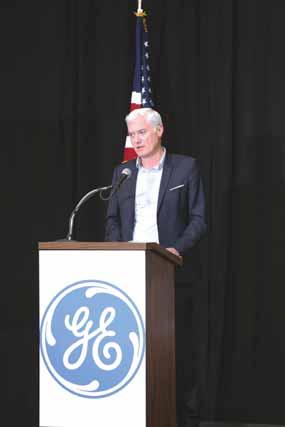
invent the concrete needed in Manila to fight against flooding if I’m not in Manila. Local customisation is essential. We have more than 40 PhD holders working across continents on fundamental research.
“Eighty per cent of our R&D work is related to sustainability. We also work on product digitalisation and market differential. We have more than 1,800 product patents – and more than two-thirds are related to sustainability. I am very proud of our open Innovation platform through which we have strong partnerships with more than 120 start-ups, either through a financial or equity stake or via an MoU [Memorandum of Understanding].”
I am keen to discuss Holcim’s recent investment in COBOD International, a global leader in 3D construction printing, to advance world-class 3D printing materials, robotics


and automation. Building on its collaboration with COBOD since 2019, Holcim aims to grow its innovative range of proprietary ink, TectorPrint, tailored for 3D printing. Holcim and COBOD have collaborated on various novel building projects, from 3D-printed windmill tower bases with GE to the world’s rst 3D-printed school in Malawi and Africa’s largest 3D-printed affordable housing project in Kenya.
Holcim’s TectorPrint is an innovative 3D printing ink range that can be tailored for complex applications from residential buildings to infrastructure. Empowering smart design, 3D printing can reduce material use by up to 50% to build better with less, with no compromise in performance.
“The reason why we are moving into 3D printing is because automation is crucial to the future of the construction industry. If you look at productivity in construction for the last 70 years, it has been almost flat or very slow growth. We really need to increase automation in construction, and one of the mass-market solutions is 3D printing. With this technology, we are building houses in Africa and headquarters in Europe. In 2023, we are also going to be using 3D printing to build concrete windmills for General Electric in North America.
“There is also a sustainability benefit when we are building with 3D concrete printing, as we are just printing the amount of concrete needed. Last year at the Venice Biennale, we presented the Striatus arch bridge that we and partners built entirely with 3D concrete printing.”
COBOD International is also partnering with CEMEX and other major global building materials players, a development that Bermejo welcomes.
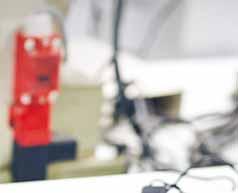




























































































































































































McCloskey’s J4 Crusher is designed to withstand the toughest conditions worldwide, delivering high TPH due to its innovative jaw chamber design and enhanced material flow. The large, deep chamber is proven to be particularly effective in hard rock applications, with an optional factory-fit rock hammer available.













Let the J4 power up your operation with these features:




•Large 42” (1060mm) x 28” (700mm) jaw opening to accommodate large feed sizes.





•48” (1200mm) wide main conveyor belt with ToughFlex® belt.
•Scalped feed production up to 500 TPH due to jaw chamber design and enhanced flow.



•Fast setup time on-site, highly mobile for site-to-site.


•12” (305mm) DSE Control Panel for high operational performance and reliability.

•Electric option available in 2023.

•365SiteConnex Telematics for highly accurate monitoring.


is among major materials suppliers that are partnering with COBOD International on

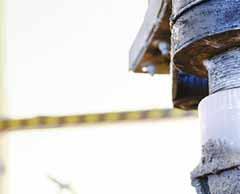

“I was more than happy to see CEMEX moving into this area. My view is, ‘Please, join us’. The more of us moving in this direction, the better chance we have of raising building standards by convincing politicians of the need for this approach.”
Another eye-catching area of research Holcim is involved in is the concrete inductive charging of electric vehicles. “This is using concrete roads and pavements to charge electric vehicles that are moving. The work in this area started with scooters. The IBIS hotel in Munich has scooters that charge when travelling over our concrete routes. We will then look at charging forklifts working in warehouses, buses and, finally, cars travelling on concrete roads. We don’t want to create over-expectation in this area. This is not widescale technology for tomorrow. It is research.”


In 2021, the GCCA launched its 2050 Cement and Concrete Industry Roadmap for Net Zero Concrete, setting out its member companies’ collective commitment to ensuring that the cement and concrete industry will play a major role in building the sustainable world of tomorrow.
Bermejo says the progressive approach to recycled building materials adopted by national and local government in Holcim’s native Switzerland enabled the group to develop, three years ago, the world’s first cement including 20% recycled construction and demolition (C&D) waste material. “That means 20% less primary resources drawn from nature. Since then, we have been looking to push building codes and create incentives to have more than 20% C&D waste in cement, not just in Switzerland but across Europe. Now, a new EU cement law being introduced in a few months will allow up to 35% of C&D waste to be used in cement for construction works. This is great circular construction progress made via the standardisation bodies.”
The ongoing development of low-carbon concrete solutions will need to answer a key question, as Bermejo explains: “Today, we have very much been producing lower carbon concrete with slag, but the lack of availability of slag, largely through steel production sites closing, is pushing its price through the roof. Fly ash is also disappearing globally. So, the key question is, ‘How can I develop a low-carbon concrete without slag and fly ash?’”
Bermejo says he and Holcim colleagues work very closely with other major and small- to medium-sized building materials companies via the London, Englandheadquartered Global Cement & Concrete Association (GCCA). Representing 80% of the world’s concrete industry outside China, the association’s mission is to position concrete to meet the world’s needs for a material that can build and support growing modern, sustainable and resilient communities.
“We are involved in the association’s common scientific network through which all company members can benefit from accessing the latest industry technologies, like CCUS (carbon capture, utilisation & storage). At the same time, I’m leading the GCCA Open Innovation Challenge involving the best startups whose ideas and solutions could benefit the entire industry by solving the issue of cement and concrete decarbonisation.”
Returning to the topic of rethinking the approach to the design of all new global infrastructure, Bermejo says: “We need to be thinking, ‘How can I make this fully recyclable and completely in line with the circular economy?’. For example, we ran a building project earlier this year where we created 100% recycled clinker to create 100% recycled cement. By the end of this year, we will start another building project involving 100% recycled concrete. We cannot do this every
day, but it can act as the lighthouse for the journey to show just what can be achieved by all of us.”
Asked how he sees the global building products industry in a decade, Bermejo responds: “It will be improving in its lower CO2 footprint, and very much about environmental transparency, with EPDs (environmental product declarations). There will be much more embracing of the circular economy and a lot more use of digital solutions, including the use of sensors in concrete to collect a lot of data that can be used effectively via artificial intelligence.” I end our conversation by asking what Bermejo enjoys most and least about his crucial work. “I like to find new ideas myself. When a new idea is coming, there is nothing better. I also like to encourage others to invent. My biggest frustration is the lack of speed in executing our plans. I know Holcim is a global leader in sustainable building product solutions, but for me, we are sometimes too shy and don’t want to be seen as arrogant. When I look at what Amazon and Google are doing, I would like us to be as arrogant as them! I always say to my teams, ‘Go, go, go and be part of the solution’.” AB




Carved by a lifetime of hard work, Rokbak articulated haulers are built to perform. Day after day. Decade after decade. From the heat of the desert to the cold of the arctic, you can rely on Rokbak. Contact your local dealer
rokbak.com







UEPG’s new Public Affairs Officer Gaspard Van Goethem (centre) recently visited nature-restoration projects in Austrian quarries
Within the framework of the EU Biodiversity Strategy 2030, the European Commission published its proposal for a Nature Restoration Law, aimed at restoring ecosystems, habitats, and species. Taking the legal form of a regulation, this proposal wants to address the looming biodiversity crisis and restore land in the long run, while more than 80% of the EU’s lands and seas are in poor conditions. Therefore, this EU-wide proposal sets both overall objectives as well as binding ecosystem-specific targets: on the one hand, the Commission intends the restoration measures to cover 20% of the EU’s land and seas by 2030 and ultimately all ecosystems in need of restoration by 2050. On the other hand, specific targets would be assigned to defined areas, such as forest, agricultural, urban, or marine ecosystems. Based on that, EU member states would have to mandatorily submit national restoration plans to the Commission outlining how they intend to deliver on the objectives enshrined in the regulation.
The aggregates-extraction sector welcomes the EU’s ambitious objectives regarding nature protection and regulation. It has, furthermore, not waited for this proposal to integrate biodiversity-favouring measures in its extraction activities. In fact, temporary land transformation featuring our activities opens many possibilities in terms of biodiversity. The Life in Quarries project initiated by Fediex – our Belgian member –and destined to develop biodiversity-hosting capacities in various quarries in Wallonia has, for instance, enabled the appearance and
development of pioneer-species populations with a high biological value. A lot of aggregates-extraction companies submitted biodiversity restoration projects to this year’s UEPG Sustainable Development Awards, showcasing our sector’s implication in the matter and explaining once more why it has a recognised record by the Commission and other environmental NGOs.
For our sector to continue this goodpractice path in terms of nature restoration and biodiversity preservation, UEPG deems it essential that a few points are clarified in the Nature Restoration Law proposal, such


New UEPG (European Aggregates Association) public affairs officer, Gaspard Van Goethem, considers the European Commission-proposed Nature Restoration Law
between Natura 2000 and non-Natura 2000 areas), the precise technical meaning of ‘good condition’ restoration, the retroactive feature of the new rules for currently extracted sites, the funding of the whole plan, etc. In that regard, the UEPG firmly intends to raise these imprecisions in the upcoming discussions in the European Parliament. The UEPG team wants to clearly voice that our sector can bring a significant contribution to the EU biodiversity objectives: Aggregates, we are part of the solution! AB

Restoration in action. An old quarry transformed into a lake, and the start of the restoration process in a currently active quarry




James Rickard, a corporate solicitor, and Laura Stanley, a dispute resolution solicitor, at law
firm Stephens Scown LLP, discuss the key legal considerations to bear in mind for anyone looking to set up a new company in the UK with another person or people




When setting up a new company with a friend, family member or business partner, you may feel that you are completely on the same page. It is important to be aware, however, that relationships can change over time, and we would always recommend that you have clear provisions in place in your company’s documents, which set out what happens if a disagreement does arise.
It is fairly common for companies to end up in a deadlocked situation whether this is at board or shareholder level, particularly in respect of companies where there are two director shareholders with 50% shareholdings. This is because neither party has a majority and therefore decisions can only be made unanimously.
There are no provisions in the UK’s Companies Act 2006 that assist deadlocked companies, and in the absence of an agreement being reached the only remedy would be to apply to the court for a just and equitable winding up of the company. This is always the option of last resort because it invariably severely harms the value in the company as it has to be wound up and the assets distributed to creditors and shareholders. The court is very reluctant to make a winding up order and it is only available in the most serious cases.
With this in mind, below are our five top provisions to include in your articles of association or shareholders’ agreement to avoid or resolve any deadlock:-




1. Chairperson casting vote at board/ shareholder level
Some companies will appoint a chairperson at either board or shareholder level (or both) and give that individual the right of a casting vote. The advantage of this is that the company will never be deadlocked at either level. However, you may be reluctant to cede this power to your fellow director/shareholder. One way to mitigate against a power imbalance is for the chairperson role to rotate on an annual (or otherwise) basis.
2. Ability to appoint a third party as director
At board level, you could include a provision which enables the appointment of an independent third party as a director to break a board deadlock. There is always a risk that the third party may take the side of the other party and you may need to think about a mechanism to ensure the appointee is neutral.
3. Re-structuring after the deadlock
Alternatively, you could include provisions which enable you to bring new investors on board and dilute the shareholdings to make deadlock less likely at shareholder level.
4. Dispute resolution clause relating to deadlock
For shareholders, it is fairly typical to include an alternative dispute resolution clause within a shareholders’ agreement. For example, where a dispute is referred to an arbitrator who will make a binding decision on the dispute or mediation to provide a framework to encourage the parties to resolve their differences.



5. Buyout clause

It may be beneficial to have a buyout clause, which enables one party to buy out the other’s shareholding in the event there is an irretrievable break down between the parties. It is important this clause contains clear provisions including (but not limited to) how the parties start the buyout process (normally by way of service of a notice), the sharevaluation mechanism and timescales for the buyout. AB
The specialist Business Owners Disputes and Exits (BODES) team at Stephens Scown has a wealth of experience in both drafting corporate documentation to give you and your business protection and providing comprehensive advice and support if your company is in a deadlocked situation. The firm has more than 70 years’ experience representing mining and minerals clients and its specialist team is recognised by independent guides to the law, The Legal 500 and Chambers.
If you are seeking advice or have any questions in relation to this article, contact James or Laura by calling 0345 450 5558 or by emailing enquiries@stephens-scown.co.uk www.stephens-scown.co.uk






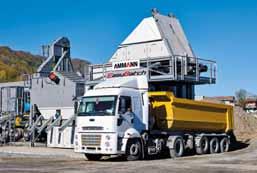




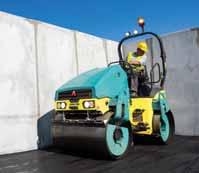

MAXIMISING YOUR INVESTMENT ARE ABOUT POWER – PURE AND SIMPLE
What do the smallest Ammann plate compactor, the largest asphalt plant and every product in-between have in common?
• Innovation that boosts productivity and efficiency, ultimately improving your bottom line.
• Parts and components that ensure long life to maximise your investment.
• The commitment of a family business that has thrived in the construction industry for 150 years by keeping promises today – and knowing what customers will need tomorrow.






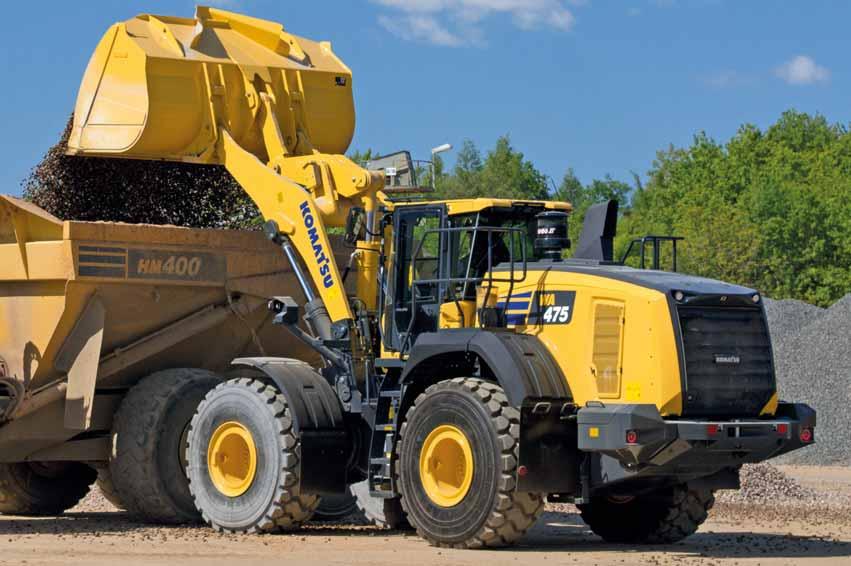








The WA475-10 is an industry-leading top performer. Its Komatsu Hydraulic Mechanical Transmission (K-HMT) and the 217 kW / 291 HP engine deliver an outstanding combination of productivity increase and ultra-low fuel consumption. An independent control of the driveline and work equipment makes your work easier and shortens cycle times, to provide you with a unique operating experience in a wheel loader.

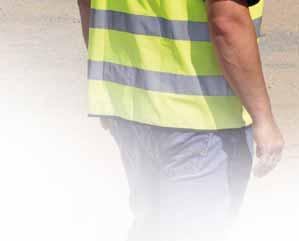






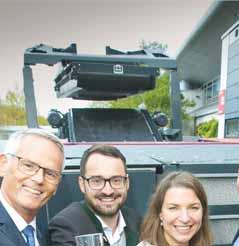




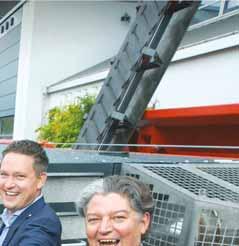






October’s bauma show saw a host of new crushing and screening plant launches from the major manufacturers. Liam McLoughlin looks at the latest offerings to hit the market

Visitors to the giant bauma show in Munich (October 24-30) were able to check out a range of interesting new offerings in the crushing and screening sector, including AI-based crushers and hybrid screens.
SBM Mineral Processing (SBM) has developed the REMAX 600 track-mobile impact crusher as a ‘technological platform’ for an AI (artificial intelligence)-based, fully automatic production monitoring and control system.
The technology is currently being developed by the company and researchers at Montanuniversität Leoben, Austria’s university for mining and metallurgy.
The REMAX 600 features a cutting-edge sensor system, video technology, powerful communication and IT networks. It will offer a set of technological innovations, such as an automatic gap adjustment facility.
It can offer up to five fractions in one cycle. With a feed capacity of 600t/h, the new machine can accommodate material feed sizes up to 900mm and a maximum total weight of 75 tonnes depending on the equipment.
Triple wind sifting and an ultra-efficient overbelt magnetic separator with longitudinal discharge as an option (a novel feature in highly mobile impact crushers) are said by SBM to ensure high purity of final products, even in recycling applications.
SBM stresses that the industry-first introduction of an 'autonomous crusher' will
help users and operators with all decisions, permanently support efficient operation, assure optimum product quality at all times, as well as make an important contribution to saving energy and costs during crushing.
The autonomous crushing R&D project has been running for two years and features interdisciplinary teams from the Montanuniversität Leoben chair of mineral processing and SBM research departments.
The project aims to make the decisive step from today’s already extensively monitored and optimised crushing operations to autonomous fully automated production by means of ‘intelligent self-learning’ mobile crushers.
The machine independently assesses feed material and final products via sensors and camera systems, registers better-than-beforethe-load conditions of crusher and conveyor equipment, and optimises all separation processes down to overbelt magnetic separators and wind sifters.
The SBM control system, Crush Control, validates all operating conditions and material properties in real time and sends the values to SBM’s headquarters via the cloud. A ‘digital twin’ compiled there matches the real machine data with thousands of stored reference data coming from 1:1 quality testing, laboratory tests and computer simulations (including rock properties, grainsize distribution curves, particle shapes, etc).
The optimisation potentials determined from this are sent back to the machine control system in real time. This allows immediate and permanent adaptation of all
process steps on site without any stoppages, says SBM.
By means of an interactive menu control, SBM says even inexperienced operators can precisely adjust the production process – depending on whether maximum output, minimum fuel consumption (eco mode) or quantity-optimised production of certain valuable grain sizes are required.
The newly integrated tool-monitoring system in the REMAX 600 is another benefit, one which counteracts shortfalls in quality due to wear during production and provides key support for preventive maintenance.
Large-scale test runs will take place in the coming year to make sure everything works as it should in practice.
Kleemann premiered its Mobirex MR 130(i) PRO mobile impact crusher. The latest member of the Wirtgen Group brand’s PRO line, the extremely powerful plant is used as a primary and secondary crusher in natural stone and recycling and meets high environmental standards, according to the company.
Local emission-free operation is said to be possible thanks to the model’s E-DRIVE diesel-electric drive with the option of external power supply.
Thanks to this external supply, the system can be operated without emissions. This ensures low energy consumption per tonne of end product. The electric drive also means that hydraulic oil is only required for setting and set-up functions. This minimises risk to the environment and further increases the system’s sustainability.

When the Mobirex MR 130(i) PRO is operated via the diesel unit, the performance and load-dependent fan is said to ensure efficient use of fuel and low noise emissions. The formation of dust is also said by Kleemann to be greatly reduced by water spraying at all relevant points, such as the crusher inlet, the discharge belts and the post-screening unit, as well as various belt covers.
The Kleemann PRO-Line system can process up to 600 t/h of material. The high output is made possible by the crushing unit with a heavy rotor and a 250kW drive in conjunction with efficient pre-screening. The Continuous Feed Systems’ (CFS) continuous feed control is said by Kleemann to ensure consistently high utilisation.
The company says it counters the increasing complexity of crushing plants with its intuitive operating concept, Spective.
In addition to a large touch panel and two Spective radio remote controls - one of them for operating all relevant functions of the automatic mode from the comfort of the excavator - Kleemann also offers Spective Connect.
The digital solution simplifies the construction site digitisation of the Mobirex MR 130(i) PRO. Spective Connect transmits all important system data to the user's smartphone and simplifies reporting.
With the Mobirex MR 130(i) PRO, the proven, robust crushing unit with its two impact rockers and versatile blow bar options, as well as the 8.4m² optional doubledecker post-screen, are said to ensure very good product quality.
Kleemann’s new impact crusher can produce and discharge two classified end sizes – without using an additional screening plan. The use of optional wind sifters is said by the German company to further increase end-product quality.
Austria-based RM has launched the new H50X hybrid screen, which can run in diesel or fully-electric modes.
As a hybrid variant, RM says the machine can be operated electrically to notch up zero emissions. It adds that the screen delivers impressive modularity and versatility.
“It’s a whole new conception of doing a scalper,” said Gerald Hanisch, founder and CEO of the RM Group. “It is not only electrified, it has all kinds of features – the mobility, the versatility, the simplicity and the energy.”
RM says that both the RM5H50X hybrid screen and the RM J110 jaw crusher – which will make its debut at Conexpo in March 2023 – have incorporated countless ideas and customer requests to redefine the application options of processing equipment.
RM says the use of a hybrid machine brings a 25% reduction in fuel costs compared to a diesel-direct crusher or a hydraulic screen, while combining them into one machine train increases the savings even further.
It adds that, when a diesel-direct crusher drives the new RM hybrid screen,
the customer saves up to 33% on fuel. In combination with an RM hybrid crusher, which drives the RM hybrid screen, the savings potential reaches up to 50%.
In addition, if only one engine is running because the crusher is driving the screen, the customer only has to refuel and service one engine, effectively saving fuel, time and money.
Hanisch added: “We have been electrifying our plants for decades, and consequently have the necessary knowhow. Now the time is ripe for us to fulfil the needs of customers with our productready solutions. The lowest possible fuel consumption and smallest carbon footprint are the order of the day for our customers to be successful.”

McCloskey International has unveiled the latest entry into its jaw crusher line in the European market, the heavy-duty J4. The crushers are particularly suited to aggregates, construction and demolition recycling, and site preparation. The Metso Outotec-owned, Canada-headquartered manufacturer says the J4 builds on the robust features of the existing product range, with a line-up of features aimed at boosting productivity and offering enhanced durability across applications.
Designed to withstand the toughest conditions worldwide, the J4 delivers high production due to its jaw chamber design and enhanced material flow. The large 1060mm x 700mm jaw opening accommodates large feed sizes, contributing to higher production in material processing.
The material path is enhanced with the 1064mm x 4247mm grizzly pan feeder under the hopper that allows for better sizing of material with a variety of mesh options. Options of either a short pan feeder to suit the pre-screen or a double-deck grizzly pre-screen are available, ensuring suitability and better sizing of material based on the application.
McCloskey says the J4 delivers effective stockpiling, with wide main and side conveyors for enhanced material flow. The angle-adjustable 1200mm-wide ToughFlex main conveyor features a 3.912m-high stockpile, and with quick release and groundlevel access, the belt is designed to be easy to maintain and service.
ToughFlex is constructed with a special weave of two fabric plies and an additional binder warp (without the need for steel wire) resulting in reduced belt weight. The plies are reinforced to resist puncturing and are protected with heavy-duty wear-resistant top and bottom covers.
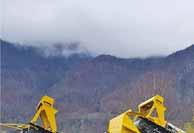




the crusher and maximise the efficiency of a project site. The company adds that technology has been a key factor in the development of the J4, with a DSE control panel for the highest operational performance and reliability providing push-button control of the jaw, track and feeder functions. The crusher is fitted with a telematics modem for the new 365SiteConnex programme, a complete connectivity solution for highly accurate monitoring of McCloskey products.
365SiteConnex is based on the latest communication technologies to collect, analyse and deliver information on the crushers, screeners and stackers customers rely on to produce the high-quality products with the least amount of downtime.


responsible strategy will be the introduction of our electric crushers, scheduled to be available in 2023.”
Keestrack has premiered the completely redesigned I4e tracked mobile reversible impact crusher with an advanced dieselelectric drive.

Due to its RIC (reversible impact crusher) technology, this machine can be used in secondary and tertiary crushing of rock, oversized gravel and recycled building materials (for example asphalt).
Keestrack says the specific design of the reversible horizontal impact crusher with a large variable crushing chamber, powerful rotor and electronically monitored hydraulic gap adjustment (+80 to -220 mm with new tools) allows feed sizes up to 250 mm and ensures consistently high-quality end products of up to 0/2 mm in closed circuit.
Secondary and tertiary crushing can be combined in one highly mobile solution, which Keestrack says makes the I4e a real alternative to mobile cone crushers or vertical impact crushers, especially with regard to its outstanding production capacities from 100 to 250 t/h.
McCloskey says that portability has not been compromised with the J4, despite its powerful capabilities. Mobility on-site and between sites continues to be a feature with remote-control tracks to move and position




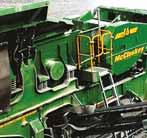
“The J4 continues the momentum for our jaw crushing product range, as we continue to develop new products that meet the evolving needs of our customers across industries,” said Toni Laaksonen, senior vice president, McCloskey International. “We have always designed our equipment to ensure it contributes to the productivity and business success of these operations. As a company that is involved in the handling and processing of the Earth’s resources, we also have our sights set on sustainability. Our next commitment to an environmentally




The manufacturer adds that the system also offers lower wear, better quality of the end products (grain shape) and significant energy savings in typical applications (for example sand production 0/4 mm: approx. -30% compared to cone crushers; -30 to -40% compared to VSI impact crushers) also due to the advanced electric ZERO drive concept, backed up by the drop-off engine/gen-set consisting of a 447kW diesel engine and 300kVa generator.
Electric drives for the crusher (160kW), feeders and conveyor belts as well as the system hydraulics enable particularly costefficient and emission-free plug-in network operation. Keestrack says that three specific patents illustrate the innovative potential of its new I4e concept.
The material enters the hopper of the I4e, the loading apron feeder, which grants no loss of fine material and ensures a long lifetime is then gradually feeding the reversable loading conveyor which has an integrated metal detector. When metal is detected the conveyor reverses and a drum magnet separates only the metal. The compact system (transport dimensions: 15,270mm x 3,000mm x 3,310mm), weighing 42-tonnes includes a single-deck after screen with return conveyor of oversized material.
“The closed circuit ensures a production of 100% final material with very high quality for any European norms,” Keestrack comments. AB
Electric prototypes, a new generation of large excavators, and a major equipment manufacturer making its debut in the European wheeled loader market are among the major recent loading-sector developments. Liam McLoughlin reports
Among the eye-catching new loader and excavator offerings at the bauma 2022 international fair in Munich, Germany (October 24-30) was the new next-generation model from Hitachi’s Stage V-compliant wheeled loader range.
The manufacturer says the ZW250-7 –which is suitable for quarrying applications - has been designed to put operators in complete control of their workspace – and master the toughest job-site conditions – with new safety features and improved comfort in the cab. It adds that the new machine puts owners in control of their profit with a high level of performance, low total cost of ownership and exceptional efficiency. Fleet and workload performance is improved due to remote-monitoring tools and services provided by Hitachi.
With the ‘aerial angle’ camera system, Hitachi says operators have an exceptional 270-degree bird’s-eye view of the job site, while the rear obstacle-detection and warning system alerts them immediately if anything is close to the rear of the machine.
Hitachi also showcased its nextgeneration of Zaxis-7 large excavators for quarrying and mining at bauma.
The cab of the new ZX890LCH-7 Stage V-compliant model offers reduced noise and vibration levels in the cab.
New features include the synchronised motion of the seat and console – to reduce operator fatigue – and the adjustable console height with three positions to choose from. Easy operation comes from the ergonomic design of the console and switches, and the hi-res anti-glare 8” screen is also easier to view.
Hitachi says that an impressive fuel saving of up to 20% (PWR mode) compared to previous models of the ZX890LCH-7 is achieved by its HIOS-V hydraulic system. It adds that this also enhances efficiency in the swing, boom lowering and arm bucket rollout. Productivity is further increased by the improved front speed for loading operations; and the increased engine output of the new Zaxis-7 machines contributes to a higher workload.
The fuel efficiency of the ZX890LCH-7 can also be controlled by using the new ECO gauge on the cab’s multifunctional monitor. Also on show at bauma was Komatsu’s





new 20-tonne class electric hydraulic excavator that is equipped with a lithium-ion battery system.
The battery system is supplied by US-based Proterra and, since January 2021, the two companies have been jointly developing electric medium-sized hydraulic excavators and conducting PoC (proof of concept) tests on advance research machines at customer sites. The machine is scheduled to be introduced to the Japanese and European markets in 2023.
Komatsu also showcased a prototype for its first fully electric compact wheeled loader at bauma. Recently designed and built together with Moog, the designer, manufacturer, and integrator of precision
control components and systems, this new connected and automation-ready construction machine is battery-powered with zero-emissions and is now ready for joint testing.
Moog’s intelligent electric system includes an electric traction motor, lift, tilt and steering electric cylinders, power electronics, system control computer, battery, and battery management system. The integrated control system connects and coordinates the actions across the machine, while the all-electric actuators and motors provide the force to the machine’s traction and loading system. The integrated nature of the system enables industry-leading system efficiency and controllability.
“To achieve our CO2 emission reduction targets from products in use of 50% by 2030 from 2010 levels, to achieve carbon neutrality by the end of 2050, we are looking for promising technologies from suppliers to accelerate our electric machine development,” said Seiichi Fuchita, chief technology officer and president of the development division at Komatsu. “The machine built together with Moog combines the strengths of both companies and was finalized within a short period of time and we expect the joint testing will show the advantages of a full electric machine and will prove collaboration is beneficial for both sides.”



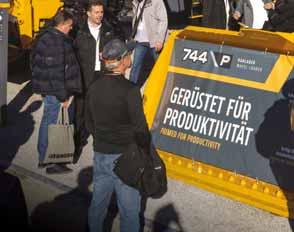
The companies say they are jointly testing the fully electric loader after bauma to prove that it can achieve a new level of efficiency, operating time, and comfort. They add that the test will show that the machine’s operating cycle is extended, and, with innovative assist functions, that it provides a “fatigue-proof” and comfortable environment for the operator to manage the machine and his day.
The prototype’s intelligent machine electrification system is designed to be connected and automation-ready. The system has the sensing and control capabilities needed for automation while the integrated software framework comes with built-in tools to coordinate multiple axes of motion and precisely controlled torque, velocity, position, and force.


Michael Wadsack, senior product manager - product marketing, at Komatsu EU, says the machine is a very early concept and will be tested for use on construction sites.
“It’s a compact machine (0.95m3 bucket) and not a typical quarry or aggregate machine,” Wadsack added. “However, customers from these segments are using also compact wheeled loaders – more as a support machine for cleaning or other services.
“At a later stage the electric concept can also be transferred to larger machines, and this is something to be considered in the long run.”
Komatsu says that the machine design replaces the loading and powerline hydraulic completely with electrical actuators.
At bauma John Deere announced its first offering of wheeled loaders in the United


Kingdom and Germany. After making their debut in the United States in September 2022, the 744 P-tier and 824 P-tier models are the first performance tiered loaders available in select European countries. As part of the Deere & Company family of brands, the Wirtgen Group will manage distribution of the P-Tier line-up through their European dealer network.
"Our customers are an integral part of our product development process and incorporating their input guides our product decisions around the globe," said Luke Gribble, solutions marketing manager for loaders and aggregates at John Deere Construction & Forestry. "That’s why we are excited to introduce the versatile and performance-enhancing P-tier models to our customers in Europe."

The manufacturer says the 744 P-tier and 824 P-tier loaders offer exceptional results at high levels with reliable components such as extra-durable axles and enhanced transmission capabilities. The extra-durable axles feature larger capacity front-axle input bearings, axle-shaft diameter and bearing size increases, and pressure-lubed frontinput bearings designed to help reduce heat, increase component life, and boost overall machine reliability.
The P-tier transmission includes a standard lockup torque converter, which adds additional torque during operation and improves fuel economy while transporting materials. The improved lockup logic is designed to increase performance and shift quality, while the updated speed sensors improve low torque shifting and downshift, improving performance when going into piles. Both loaders come equipped with the John Deere 9.0-litre engine that increases horsepower while minimising fuel consumption.
Electric actuation has previously been utilised by Volvo CE on an electric mini excavator prototype in 2017, while RG
LeTourneau pioneered the technology in the 1960s.
The first Volvo EC550E excavators to be deployed in Great Britain are proving to be a highly productive and profitable addition to Ashcourt Group’s fleet of earthmoving equipment from SMT GB.
Yorkshire-based Ashcourt Group was the first customer to place an order with equipment dealer SMT GB following the launch of the new EC550E crawler excavator and has now received the first two units in the country.
The EC550E features a larger bucket and upgraded structural components to enable operators to achieve productivity comparable with a much larger machine, while the new electro-hydraulic technology is said to deliver significantly greater fuel efficiency.
“We were instantly impressed by the specification and the development of the machine with the new hydraulic system, the new electronics, and the new engine technology, so it was prime that we got the orders in,” said Paul Martin, plant director at Ashcourt Group.
The family-owned construction company will use one of the new Volvo EC550E excavators for civil engineering projects, where its strong lifting capacity will come into play. In mass excavation configuration, the second machine will work primarily
at Ashcourt Group’s Partridge Hall Quarry, helping on earthwork jobs as needed.
Ashcourt Group typically runs the chalk quarry near Burnby, which it has operated since 2014, with one excavator to rip out material from the face and one loading shovel to fill the mobile crusher and screeners, sort the piles, and load the Volvo FH trucks to transport the aggregates and lime away from the site.
“Because chalk has a low profit percentage, it is better to have fewer machines and staff but with greater productivity,” said Ashcourt Group’s quarry manager Damian Towse.
For the last few years, the company has paired a Volvo EC480E crawler excavator with a Volvo L260H wheeled loader. The new EC550E excavator, however, promises 20% greater production than the EC480E in typical dig and dump applications thanks to its larger bucket and faster cycle times.
The larger bucket is enabled through the increased undercarriage dimensions (for stability), as well as the upgraded structural component dimensions on the frames, boom, and arm. The faster cycle times result from the engine’s high torque at a relatively low rpm combined with large displacement pumps. The 2200Nm (340kW) engine is well in line with much larger competitor machines.
Martin commented: “Fuel efficiency is
A recently purchased Cat 374 crawler excavator has been showing its worth in loading and rock-breaking operations at the Arids Garcia granite quarry near Barcelona in Spain.
As well as primary loading, the excavator has already proved useful in a spectacular and productive speciality of dropping a 7-tonne iron ball to break up rocks instead of using a hammer for oversize management. The process is carried out by one specialist operator.
The quarry has a long history of using Cat loading equipment, having first purchased a Cat 950 wheeled loader in 1972. Since then, all the loading and transport operations at the quarry have been carried out with equipment from the same brand.
Currently, the quarry has four Cat 30- to 80-tonne tracked excavators for loading the material after blasting: a 330C, 340F, the newly-purchased 374 and a vintage 329E which has been on the site since 1987 and is used for operating a hammer. Four rigid dumper trucks (Cat 769 and Cat 771 models) transport the material from the quarry
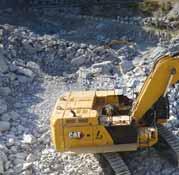
key for us with red diesel no longer being available and the price of fuel going up. It's important for our cost per tonne in the quarry but also when we are pricing up external projects. We are now looking at fuel month on month across the whole fleet and are trying to drive down the cost of fuel as far as we can. We hope that buying these two EC550E excavators will help us keep on top of that."
The improved fuel efficiency on the EC550E comes from the new electrohydraulic system, which uses independent metering valve technology (IMVT) instead of a conventional spool-type main control valve (MCV) – an industry-first in this excavator -size class. Oil is pumped exactly according to demand to eliminate hydraulic losses, reduce fuel consumption, and give excellent controllability.
Ashcourt Group has been an SMT GB customer for around a decade. Currently, with 120 pieces of plant equipment, around 98% of which are Volvo brand, Ashcourt Group is incrementally increasing its fleet to meet market demand for both internal and external projects.
“Besides the two EC550E excavators, we are purchasing 45 other new Volvos this year. It’s a massive investment for the business, totalling over £5m, and we’re looking forward to seeing all the new equipment come through,” Martin said. AB


face to the reception hopper at the crushing plant. Four Cat wheeled loaders – a 966M XE 962K, 950H and 936E - handle the finished products and load external trucks, while a Cat 438 backhoe carries out small work and cleaning tasks.
The quarry produces about 500,000 tonnes per year, with a maximum production capacity of 6,000 tonnes per day.
The new 74.17 tonne Cat 374 produces 361kW of net power and is the largest excavator operating at Arids Garcia, replacing the previous version of the 374 it owned.
It started operating at the site on August 24 this year, and quarry managing director Jordi Garcia is already impressed: “It is a very good machine, it’s the second one we’ve bought of the same model. Its main characteristics are reliability, speed of movement and low fuel consumption.”
“We are satisfied with the quality and efficiency of the equipment. The new 374 consumes around 37 litres of fuel per hour, less than half that consumed by a larger excavator we were operating seven years ago for the same level
of production. We are very happy with the service we receive on our equipment from our Cat dealer Finanzauto.”
Finanzauto is the Cat dealer for Spain and Portugal. Its full line of quarry products includes wheeled loaders, tracked excavators, rigid dump trucks, articulated dump trucks, attachments, as well as generators and other auxiliary machines. It has around 4,400 quarry customers in Spain, mostly small, family-owned companies.
Finanzauto’s Barcelona branch manager and northeastregion director Luis Sánchez says that rental is important for the company, representing 20% of its business. “Usually we rent longterm – six months to one year,” Sánchez says. “In rental, excavators and wheeled loaders are the most popular machines. The Cat 950, 966 and 972 wheeled loaders are very popular.”
The Barcelona Finanzauto branch has a 1,700 sq m workshop which normally has around four machines being worked on by up to eight mechanics, which undergo Cat Certified Rebuilds including engine and powertrain rebuilds.
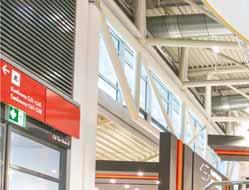









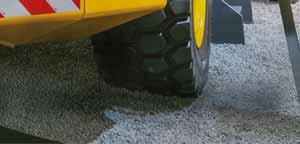


Advanced testing of driverless articulated dump trucks (ADTs) and the growing presence of 4x4 ADTs are key talking points in the global off-highway hauler market. Guy Woodford reports
At bauma Munich 2022 (24-30 October), Bell Equipment showcased its new generation, two-axle B45E 4x4 ADT and a Bell B30E with a vehicle width of less than three metres. The South African-headquartered articulated hauler giant also highlighted its eye-catching and extensive autonomous articulated hauler testing programme.
As reported by Aggregates Business earlier this year, as an addition to its range of seven ‘traditional’ 6x6 ADTs, with payloads from 18 to 45.4 tonnes, Bell Equipment is the only global ADT manufacturer to offer a parallel three-model (B60E 4x4, B45E 4x4 and B30 4x4) range of two-axle ADTs for the past six years. Each ADT is aimed at a different market segment and represents a strong operating offer thanks to the advantages of the 4x4 ADT concept. In the right applications, Bell Equipment says the models outperform conventional rigid dump trucks (RDTs) that need good haul roads and the three-axle ADTs are designed for extreme off-road mobility.
Speaking to Aggregates Business at the exhibition, Brad Castle, territory manager at Bell Equipment, said: “You don’t always need a 6x6 ADT in a quarrying environment. In a B30E, for example, the 4x4 version has a 13% smaller turning circle than its 6x6 equivalent. That makes a big difference when you need to turn around on-site. The 4x4 haulers also reduce tyre wear and road maintenance costs, as you don’t have middle tyres like a 6x6 dump truck, which causes scuffing.”
Castle says the fact that Bell Equipment
and Doosan Infracore are the only two ADT manufacturers offering 4x4 articulated haulers has facilitated adoption by quarrying customers. “It is a niche product line but one that is very much needed. The 4x4 models have been developed through our Specials [applications] department in [Richards Bay, KwaZulu-Natal], South Africa. The truck’s power head is the same as the 6x6 equivalent, with the rear end being the difference. Our 4x4s have become known in the US as a ‘quarry’ truck. It doesn’t replace our 6x6 ADTs; it competes against [40-tonneclass] rigid dump trucks.


“The fact that our 4x4s have drive on both axles, compared to RDTs with drive on one axle, gives it a capability edge. The B45E 4x4 now comes with full suspension as standard, rather than the previous rigid rear with no suspension on the back. This offers more operator cabin comfort. We also offer a narrow or standard bin option, with the narrow bin preferred when operating under a crusher feed hopper.”
Castle stresses that fuel consumption and tyre wear are the two biggest costs linked to running an ADT fleet, with Bell Equipment “known” to offer the lowest articulated hauler fuel burn globally. Now, with its 4x4 ADT range, Castle says Bell Equipment also has a great offer on reducing fleet tyre wear compared to 40-tonne class RDTs.
“We had a quarry customer in South Africa running B60E 4x4s. They calculated their tyre wear costs against their rigid trucks, and they narrowed it down to how much in rands and cents the B60E 4x4s’ tyres were saving them – and it was 2 rand 28 per tyre per hour. You add that up over many working hours across a fleet, and it’s a huge saving.”



In 2019, Bell Equipment completed a €17mn facility at its Eisenach-Kindel assembly plant in Germany. The new production complex makes ADT components for the Northern Hemisphere. With around 12,000m² of floor space, the facility tripled the available space at the Eisenach-Kindel site. The new site directly adjoins the main factory hall. It provides in-house manufacturing of truck components in Europe for all seven Bell ADT models (B20E to B50E) assembled in Germany. Emphasising the commercial
advantage this gives Bell Equipment, Castle says: “Like any heavy equipment, our ADTs are only as good as their support. You must keep the machines running, or customers lose money, so having a factory in Germany closer to our [Northern Hemisphere] customers is hugely important. We expanded the factory significantly two to three years ago, and it’s now three times larger.” Bell Equipment announced earlier this year that it would increase its ADT manufacturing at Eisenach-Kindel due to the strength of the company’s North America and Western Europe sales. Kiesel, Bell Equipment’s German dealer, reports that its strongest ADT demand comes from quarrying businesses, particularly keen on the 4x4 haulers.
Since 2020, Bell Equipment has been working closely with xtonomy and Voestalpine at a lime quarry site in the Alps, where xtonomy has fitted its iTruck autonomous haulage system (AHS) on two Bell B30E ADTs with great results.

A link-up with Pronto AI, an American safety and automation technology developer, followed, including the official launch of Pronto AI’s autonomous haulage solution at MINEXPO 2021 in Las Vegas last September. A full test site has since been established in Reno, California, where three autonomously operated Bell B45Es and a Bell B50E are working in a sand mine. A second US test site, at a Texas sand mine, has also been created in recent months.
“We now offer an autonomous-ready articulated hauler, with our partners’ technology talking to the machine,” says Castle. “We have customers talking to both xtonomy and Pronto AI about real-world applications.
“I visited Pronto AI’s Californian quarry test site last month [September], and it was quite something to see the ADTs driving around the site with nobody inside. We are actively talking to customers in America about this technology. It is very software intensive and hardware minimal, with the
“The challenge with hydrogen is how to store it on the articulated hauler, as it takes up a lot of space”
Tristan du Pisanie
head of product development
have videos playing here [at bauma 2022] of our test sites, and you see the driverless ADT stop when someone gets near it. Where site connectivity allows, the autonomous hauling solution in quarries will really take off over the next year.”
Joining Castle in conversation with Aggregates Business, Tristan du Pisanie, Bell Equipment’s head of product development, highlights the articulated hauler major’s development on making its machines compatible with alternative fuels.
“All our ADTs are fully compatible with HVO (hydrotreated vegetable oil). We believe HVO is a very good low-carbon solution,
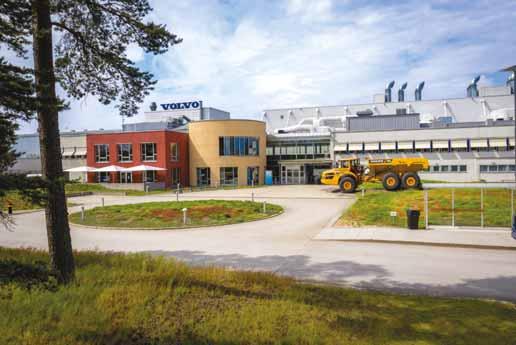
The biggest controversy I have heard recently is people who get palm oil from countries where it is unsustainably grown. That can give HVO a bad name. If you use the right raw material, it is a great solution for our customers that are carbon-reduction minded.
“Longer term, the size of our machine range is probably not compatible with where batteries are today; they are too big, and the energy cost is too high, making them too expensive. So, we are looking at alternatives, and the only two things that look feasible are hydrogen fuel cells and hydrogen internal combustion engines. Both will need a lot of investment around production and supporting infrastructure. The challenge with hydrogen is how to store it on the articulated hauler, as it takes up a lot of space, considerably more than conventional fuel, like diesel. You need around twice the size of a diesel fuel tank to run on hydrogen for four hours at a time. It must be said, though, that we don’t know for sure the direction our low-carbon journey will end up taking us, and I believe that this is true for all OEMs. Technology is changing every day, and we don’t know which solution will advance faster than the rest.”
Volvo Construction Equipment (Volvo CE) has announced its intention to invest SEK 360mn (€33.05mn) into its production facility in Braås, Sweden, between now and 2027.
The facility in Braås, long recognised for its environmental credentials, specializes in the design and manufacture of articulated haulers for the global market. It produced a fossil-free construction machine that was the first in the world to be delivered to a customer - an A30G which is now in use on customer NCC's worksite.
The decision of AB Volvo's board of directors to invest in Braås means that the factory will be adapted over the coming years to enable it to produce a larger range of articulated haulers with different powertrain types, reflecting the shift in demand towards equipment with more sustainable power sources.
The investment will be used to extend production capacity at the 45,000 m² site in southern Sweden to broaden the product range going forwards, with the addition of new buildings and production equipment. Setting its sights firmly on the future and in line with its purpose to build the world we want to live in – and workplaces we want to work in - Volvo CE will also invest in









automation and ergonomics to both reduce the need for employees to engage in repetitive tasks and create a safer work environment.
Pioneering manufacturing techniques is nothing new for Braås. Since producing one of the world's first series manufactured articulated haulers, the ‘Gravel Charlie’, a 10-tonne hauler, in 1966, the facility has been at the forefront of innovation. The site is most famous for producing the largest articulated hauler in the world, the 60-tonne class A60H, a real feat of engineering.
As well as constructing the world's first articulated hauler made from fossil-free steel, the engineering talent based here has also been instrumental in the building of the world's first prototype articulated hauler powered by hydrogen fuel cells – the concept Volvo HX04 – which is currently the focus of testing to develop future hydrogen solutions.
Braås is also leading the way in environmental protection and was the first in the construction industry to achieve a carbon-neutral operation powered entirely by renewable energy. In 2018, the site also became a zero-landfill facility.
"The transport and construction industry is undergoing a transformation with, among other things, an increasing number of electrified vehicles," says Jonas Lakhall, site manager at Volvo CE in Braås. "This investment will enable us to adapt and extend our production facility so that we can offer a broader range of machines – with different powertrains – to our customers and help them meet their emission reduction ambitions.
"It is important for us to continue to be at the forefront and make clear decisions to meet our Science Based Target commitment to achieve net-zero value-chain emissions by 2040. By adapting our production for electric machines, we are progressing along our electrification roadmap.”
Hyundai is now offering two ADTs, the HA30 and HA45, with capacities of 28 tonnes and 41tonnes respectively. The machines may be new to the Hyundai brand but feature proven designs and technology.
The machines are the well-accepted Doosan models built in Norway and now being offered in Hyundai branding following the tie up between the firms.
The firm claims equal weight distribution due to the sloping rear chassis frame
design, which is said to deliver stability by distributing more load towards the centre of the machine and resulting in a low centre of gravity. The machines also have the proven tandem rear-axle bogie configuration, which is said to offer a higher degree of articulation than competing designs and optimises ground contact to maximise traction. The machines also feature the articulation joint-turning ring mounted close to the front axle, which further helps to equalise load distribution between the front to rear and across the front axle during steering.
The trucks are powered by Stage V-compliant Scania diesels. The HA30A uses a five-cylinder, 9.3-litre, DC9 turbocharged diesel, developing 276kW and 1,876Nm of torque. The larger HA45A employs a six-cylinder, 12.7-litre DC13 diesel engine, producing 368kW and 2,476Nm of torque.
Both engines drive through eight-speed ZF automatic transmissions, with integrated retarders. The torque converter has lock-up in all gears, reducing fuel consumption and increasing efficiency. Fuel, AdBlue diesel engine exhaust fluid and a standard auto-lube greasing system can all be easily accessed from ground level. The engine canopy tilts forward for access to filters and fill points, while the cab structure can be tilted to provide access for repair and maintenance.
Hyundai’s Himate telematic monitoring system is fitted standard, with satellite and GSM connectivity. This allows customers to monitor productivity, fuel consumption, system warning and maintenance status remotely, reducing downtime and improving fleet utilisation.

Italian company Perlini has launched the new DP265WD dump truck for the quarrying, mining and public works sectors.
Referred to by the manufacturer as “the little one” in its range, the 26.5-tonne truck features new control electronics, modern GPS monitoring and electronic weighing systems.
The width of less than 3m allows for road transport without the need for special transit permissions or escorts.
The vehicle’s features include a brake/ retarder system with oil-bath brakes, oil-pneumatic suspension, and a Stage V Scania DC09 engine and an Allison 4430ORS transmission with update electronics.
Showcased at bauma 2022, the DP265WD also features a new digital electronic system which enables real-time monitoring of all system parameters, including remotely.
The on-board GPS available in the new dump truck connects to the vehicle’s power supply and constantly collects the status of its main parameters including position, speed, direction, panel status check on/ off progressive mileage and on-hours of the panel. It then transmits them via GPRS to a web-monitoring platform.
Requiring a robust, reliable articulated hauler to remove overburden for ten hours a day, five days a week, Erdbau Schrader found the perfect solution with Rokbak and its RA30.
In a pit near to Calbe, a town in the district of Salzlandkreis, in Saxony-Anhalt, Germany, around 6,000 tons of gravel is removed daily by earthworks specialist Erdbau Schrader. Gravel extraction started at the site around 30 years ago and it’s expected to continue for another three decades. Now navigating this
tough terrain, up and down steep inclines to unload around two kilometres away, is the Rokbak RA30, the latest addition to Erdbau Schrader’s fleet.
"We chose Rokbak because of its reliability and the price-performance ratio, as well as the hauler’s ability to cope with our long, heavy off-road operations,” says Ines Schrader, managing director of Erdbau Schrader. “We also wanted to ensure that our experienced operators would be able to work with maximum comfort.”
Erdbau Schrader was founded in April 2011. The company specialises in removing overburden for gravel extraction and renaturation, utilising its machines at several locations near its bases of Staßfurt and Brumby. Erdbau Schrader already owned four Terex Trucks TA300s – which it bought before Terex Trucks rebranded to Rokbak in September last year. In July, the company added the RA30 to its fleet, purchasing the machine from Rokbak dealer KlarmannLembach. Three other articulated haulers are working alongside the RA30 at the pit near to Calbe.
“The Rokbak RA30 is a strong, reliable and high-performing machine – which is exactly what Erdbau Schrader needed,” explains Klarmann-Lembach salesman Thomas Keil, who recently visited the Calbe site with Rokbak to see the RA30 in action. “Our confidence in the Rokbak brand and the haulers is such that, when we were approached, we could assure our customer that the RA30 was the ideal addition to their fleet.”
Erdbau Schrader’s articulated haulers move at full power five days a week, for ten-hours from 6am until 4pm. Materials from the site are transported over sandy and spongy ground for two kilometres before being unloaded at a railway loading station. The RA30 has to navigate tough terrain, prove its durability over long shifts and be a machine that employees want to operate.
With the capability of transporting a

a maximum engine power of 276 kW (370 hp) with a heaped capacity of 17.5m3 (22.9yd3) and a maximum torque of 1880 Nm @ 1400 rpm. All Rokbak haulers can be relied upon to operate effectively and efficiently, with optimal traction in difficult terrain, combatting steep inclines with ease. Routine maintenance is as quick and efficient as possible, keeping service time and costs to a minimum.
Furthermore, the factory-approved parts are backed by a two-year/6,000-hour warranty – one of the most comprehensive guarantees in the industry. Operational comfort is also at the forefront of the RA30 design. A spacious, ROPS//FOPS-compliant, pressurised cab with excellent heating, ventilation and air conditioning (HVAC) keeps the operator comfortable and focused.
“Our operators have highlighted to us that

reliable and easily adapted to our heavy, difficult working conditions,” says Uwe Schrader, who oversees machine usage at Erdbau Schrader. “The notable construction of the front axle, with true independent front suspension, offers a very high level of operator comfort across a comprehensive ten-hour working day, which is further elevated by the fully automatic eight-speed transmission.”
The RA30’s EP320 transmission comes with eight forward gears as well as four reverse gears and features a top speed of up to 55 km/h (34 mph), high overall gearratiospread, equal ratio steps between gears and optimised gear shifting with partial load shifts. All of this means that the RA30 offers lower fuel consumption with smoother gear shifting and thereby higher levels of operator comfort as well as faster cycle times and reduced carbon emissions.
Overall, the entire drivetrain helps the hauler deliver class-leading rim pull for superior performance and productivity. It also ensures the machine offers excellent navigation and fast haul cycles. The RA30’s long-life transmission fluid increases the length of time between oil maintenance intervals to 4,000 hours. This helps customers achieve increased productivity and uptime, as well as lower cost per tonne.
“The RA30’s transmission strikes the perfect balance between efficient power, effective gearing and weight distribution, allowing the hauler to move more loads quicker,” concludes Thomas Schmitt, Rokbak’s customer support manager for Europe. “The RA30 is simple to operate and easy to maintain, it delivers low total cost of ownership with a fuel-efficient performance and high productivity – so it’s no wonder the Erdbau Schrader team are so happy with it.” AB




Doosan gave a world premiere at bauma Munich 2022 of itsfirstever 4x4 articulated dump truck (ADT). The new 4x4 version of the DA45-7 ADT complements the company’s standard, popular range of 6x6 ADT models, including the 28-tonne DA30-7 and 41-tonne payload DA45-7. The 4x4 DA45-7 aims to compete
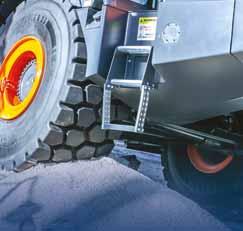
with 40-tonne-class rigid dump trucks.
In Doosan’s new 4x4 ADT, the front truck and cab unit is the same as in the original 6x6 model, with modifications being made on the rear dumper unit only. Featuring a ZF EP8-420 transmission, the 4x4 DA45-7 is a two-axle ADT with twin wheels


at the rear, and with a dumper section like that on RDTs in the 40-tonne class.
Speaking to Aggregates Business at the showpiece event, Beka Nemstsveridze, Doosan’s ADT product manager, said: “This machine is an alternative to the traditional 40-tonne-class rigid dump truck applications. When
it starts raining and there is mud on a smoother surface, a rigid dump truck can stop working. The DA45-7 4x4 fills this gap and can increase the working season. You can also climb higher inclines with this ADT than a 40-tonne RDT, and there is a price difference between a rigid dump truck and an ADT 4x4.”



No matter how challenging your needs, EARTHMAX SR 41 is your best ally when it comes to operations that require extraordinary traction. Thanks to its All Steel radial structure and the special block pattern, EARTHMAX SR 41 provides excellent resistance against punctures and an extended service life. In addition to long working hours without downtime, the tyre ensures extraordinary comfort.
EARTHMAX SR 41 is BKT’s response to withstand the toughest operating conditions in haulage, loading and dozing applications.

For info: europe@bkt-tires.com



The comprehensive Matec Industries’ plant solution for AAL Recycling







Washing plants are a crucial and evolving element of the production of high-quality aggregates and sands. Guy Woodford reports on some of the latest in-demand solutions
UK-based AAL Recycling (AAL) began trading more than 30 years ago as a one-man, one-truck, one-excavator company. It is now one of the largest demolition, hauling, recycling and excavation companies in Jersey and the Channel Islands, employing more than 85 people and with a fleet of more than 70 vehicles.
Currently, AAL operates the island’s commercial and household construction waste-recycling centre in La Collette, supporting the island’s sustainability project in every way possible. The demolition and excavation area has had the company’s fastest growth, thanks to managing some of the most complex projects developed on the island in recent times. Given the great growth of AAL Recycling (AAL), its owner and CEO, Alan Langlois, approached Matec Industries (Matec) to find innovative and technological solutions that would allow processing up to 150t/h of recycled material, with water consumption of less than 25m³/h.
The plant would have to comply with all current regulations, ensuring low energy consumption, and maintaining a high washing and sorting performance of the processed material.
To ensure that more than 95% of water used during washing and sand sorting was recycled, a complete wastewater treatment and filtration plant was installed by Matec for AAL. From the collection tank, turbid water is pumped into the decanter through the stainless-steel piping via the

use of a centrifugal pump. The flocculating polyelectrolyte solution is injected into the feed line of the settler and reacts with the suspended solids in the liquid, speeding up the natural sedimentation of the mud particles.
The turbid waters arrive in the vertical decanter where the reaction of the polyelectrolyte takes place, aggregating the sludge particles and causing them to precipitate. The clarified waters, free of suspended solids, then rise to the top of the decanter and by weir and are collected in the perimeter channel located at the top of the decanter. They are then conveyed to a stainless-steel clean water tank. At this point they are ready to be reused in the production cycle again through the clean water relaunch pump.
The sludge, meanwhile, settles inside the cone and is discharged once it reaches the required consistency by the opening of the automatic valve. It is sent to the homogeniser tank below where it is kept in slow agitation. At this point it is ready to be fed into the filter press. The Matec filter press is an industrial machine designed to achieve the best results in dewatering industrial or civil fluids (often referred to as sludge).
Matec filter presses are designed for use with High Pressure Technology (HPT), capable of working at both operating pressures common to all filter presses and at higher pressures.
The wastewater treatment and filter press module consist of a 1500×1500 filter press with 170 TT plates; a BIFANG 100,000litre
sludge homogenisation tank; a 220,000litre static vertical decanter; a 6,000litre/minute clean water pump; two clean water tanks (10,000litre and 40,000litre capacities, respectively); a BIFLOC automatic flocculant management system; a 6,000litre/minute centrifugal pump for loading vertical decanter; and a 50,000litre dirty water tank.
An AGGRETEC 150 semi-mobile screening and washing unit, and a SCRUBTEC LW-080500 heavy scrubbing unit were chosen for washing, grading and drying AAL’s product range. AGGRETEC is Matec’s rapid
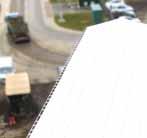
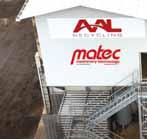


AAL Recycling’s Matec solution allows for the processing of up to 150t/h of recycled material, with water consumption of less than 25m³/h



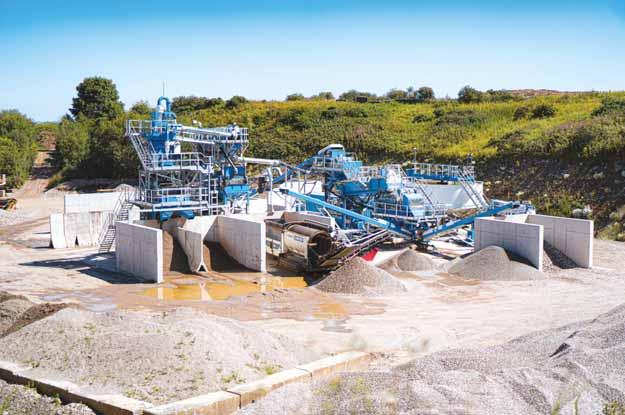
including aggregates, recycling, reclamation and mining. Being a semi-mobile system, it is easily transportable making it ideal for working on construction and demolition sites. The solution for AAL consists of three conveyor belts (for 0-2mm, 2-4mm, 25-40mm product); a sand recovery unit with hydrocyclones; three-deck vibrating screens; a magnetic belt separator; a feeder screen; and a loading hopper.
The SCRUBTEC LW-080-500’s combination of an intense cleaning action and its removal of light contaminants are said to make it a key component in construction and demolition waste-recycling systems. It is also ideal for aggregates and mined materials with high clay content.
The material is rubbed through inclined paddles arranged in series inside the machine. These paddles slow down the material feed when it is very dirty but ease the feed when it is cleaner. The entire washer is coated with an interchangeable wearresistant steel armour.
The SCRUBTEC LW-080-500 comprises a log wash, impurity screen, a dryer/finishing screen, three conveyor belts (16-25mm, 10-16mm, 4-10mm product), and a pre-screening solution.
Skipway recently opened its doors
technology is supporting the Northern Ireland-based waste-management firm to divert over 95% of its trommel fines from landfill. The 16-17th November showcase began with a guided tour of CDE’s worldclass manufacturing facility in Monkstown, County Antrim, Northern Ireland.
Guests saw the 300,000 sq. ft. facility in operation, where CDE’s advanced wet processing solutions are commissioned for customers around the world, from Creagh Concrete in Toome, Northern Ireland, to Posillico Materials LLC on Long Island, New York; Repurpose It in Melbourne, Australia, to Feiring Bruk, Norway.
As part of a long-term investment strategy in its manufacturing capabilities, CDE recently commissioned two new Bystronic high-speed sheet-metal laster-cutting systems. The systems integrate with a new 400-tonne steel storage and management system incorporating fully automated loading and offloading of the laser cutters.
Following the tour of CDE’s facility, guests were invited to tour its latest trommel fines solution, designed and engineered for Skipway.
The new 50tph trommel fines plant, the first in Northern Ireland, has been commissioned at the waste-management
rm’s processing site in Dunmurry, near Lisburn, and is one of of three recycling facilities it operates (the other two are in Belfast and Portadown). The CDE solution for Skipway incorporates an AggMax modular logwasher, EvoWash sand wash plant with Counter Flow Classification Unit (CCFU), AquaCycle thickener and static screens.
The state-of-the-art plant diverts trommel nes from landfill and converts the material into a resource by producing recycled products with the same specification and quality as quarry-grade sand, therefore making it suitable for concrete and building products while also improving the quality of other recycled aggregates such as pipe bedding and recycled hardcore.
Skipway director Trevor Heatrick said: “By putting trommel fines through a wet processing plant, the clean sand and aggregates recovered can be resold and reused in the secondary aggregates market. This minimises disposal costs, as well as closing the loop on challenging waste streams to create a more circular economy and generating additional revenue for our business.”
Mansfield Sand Company Limited has been quarrying sand in Nottinghamshire, England, for more than 170 years. It is known countrywide as a supplier of materials for top-class sports and sporting venues across the UK and Ireland. It supplies sand material to 16 Premier League clubs, 16 Championship clubs and 120 other football league and non-league clubs for use in their stadia and training ground facilities.
Besides sand for football stadiums, Mansfield Sand also produces a wide range of products for landscaping and equestrian uses, including championship golf and world-class show-jumping arenas, as well as asphalt sand, foundry sand, and sand for concrete and brick products.
In 2014, Mansfield Sand wanted to upgrade its plant and control system to process a new deposit. It required a plant



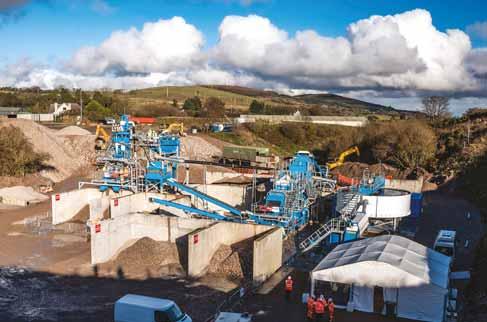






that would process 300tph of -65mm sand to manufacture their various products, including golf sand that meets United States Golf Association standards, block pavior sand and asphalt sand.
In addition to this requirement, the local planning commission also set a noise restriction in place so the new plant would not disturb some rare birds nesting near the boundaries of the site. It was at this time that Neill Rowland, McLanahan applications engineer, knocked on their door. He explained that McLanahan could offer them a Hydrosizer sand plant that would produce five different products in one pass.
“One of the things that sold the plant was McLanahan’s technical ability to offer this,” said Rowland, noting that experience and confidence also played a role in Mansfield Sand’s decision to work with McLanahan.
Mansfield Sand was familiar with Hydrosizer systems from an existing plant they had been operating for several decades, so they had already realised the benefits of Hydrosizers for what they were trying to achieve.
“When you start getting down to really fine sizing, Hydrosizer classification is really more efficient and more cost-effective,” explained Rowland. “The Hydrosizer is the only piece of equipment suitable for the application to achieve the tight tolerances.”
McLanahan installed a Hydrosizer plant incorporating McLanahan Pumps, Sumps, Hydrocyclones, Separator, Dewatering Screens and Blending System with the ability of blending to 1% accuracy to help Mansfield Sand meet the strict specifications required of their final products. The final products are discharged at less than 15% moisture, which creates stockpiling efficiency and allows for further drying processes.
To meet the requirements set forth by the planning commission, the entire plant is housed within a galvanized structure, clad and insulated to reduce the noise level. The plant’s components are also lined with rubber to protect them from the abrasiveness of the sand. After some calculations from Mansfield Sand’s laboratory technicians, the company discovered the waste from the wash plant would fill their lagoon within 18 months, so it turned to McLanahan for help with its water management.
McLanahan provided an Ultra Fines Recovery System to recover fines down to 40 microns to extend the life of Mansfield Sand’s lagoon system.
“Anything bigger than 40 microns is recovered,” Rowland said. “Anything less is going to the lagoon.”
Since commissioning the Hydrosizer plant, Mansfield Sand Company has not received a single customer complaint due to the performance of the equipment. The plant’s modern control system gives Mansfield Sand the ability to adjust the product to meet consumer demands.
“The plant does have quite a bit of functionality for them to develop product and potentially react to market changes,” explained Rowland.
In four years of operation, the Hydrosizer plant has proven to be both stable and reliable. It produces a consistent 280tph, and to date, the plant has produced 2 million tons of sand for Mansfield Sand Company. Furthermore, the Ultra Fines Recovery system has doubled the life of its lagoon by allowing Mansfield Sand to capture the fine material.
“It’s a low-value product, but it’s a product they can sell, and it’s a product that isn’t filling their lagoon, which is the real benefit to them,” Rowland said.
Overall, Mansfield Sand is pleased with the Hydrosizer plant and Ultra Fines Recovery System.
“A good team effort by both parties and a professional working relationship providing a technologically advanced plant gives Mansfield Sand flexibility, controllability and future-proofing for the estimated 30-year life of the site,” said Richard Abraham, managing director of Mansfield Sand. “Now, four years

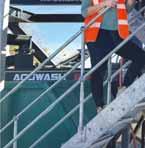
on, we continue to have a fantastic working relationship together. Our process plant continues to manufacture our premium quality sands to Mansfield Sand’s exacting standards.
The partnership between Mansfield Sand and McLanahan has rested on the McLanahan team’s awareness of the importance we place on the reputation of our products and our respect for their experience. The partnership had a lot to prove, and it proved to be a great success.”
Terex Washing Systems was at bauma 2022 in Munich, Germany, where it staged a live demonstration of its AggWash 60-1 washing and recycling plant, capable of producing up to four high-quality aggregate and up to two sand products at up to 70t/h.
An innovative plant that integrates heavy attrition with sizing, lightweight contaminants removal and hydrocyclonebased fines recovery in a single highly portable chassis, AggWash is a rapid-install solution for a wide range of applications within the aggregates, recycling, remediation and mining sectors.
The AggWash 60-1 has a modular design and comes pre-plumbed with a single connection point for quick set-up. The machine’s log-washer angle adjustment allows increased material retention and removal of trash, while the overband magnet on its feed conveyor removes ferrous metals. The AggWash 60-1’s rubber-lined pumps, cyclones and transfer points are also said to extend the plant’s life. AB













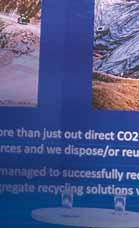
With materials costs rising and resources depleting, regulations are calling for the adoption of sustainable solutions and recycling of construction waste. Recyclingplant providers say the equipment is already there to produce the sustainable construction materials of tomorrow. Liam McLoughlin reports
As the construction industry continues to cope with issues around the availability and cost of raw materials, the potential of construction, demolition and excavation (CD&E) waste to address the challenges facing the sector has been highlighted.
CDE, the sand and aggregate wet -processing solutions provider for the natural -processing and waste-recycling sectors, set out the role of its technology in supporting the circular economy and zero-waste agenda at this year's bauma event in Germany (24-30 October).
The company was joined on its stand at the Munich exhibition by a number of its European customers for a series of round table discussions on the future of recycling. One of these was Norway-based sustainability pioneer Tom Wilhelmsen. The company’s waste-management division Massebalanse Norge is shortly set to commission its new CDE waste-recycling plant at Disenå in Norway’s second-largest county, Innlandet.
Tom Wilhelmsen’s CEO Gilberto Enkerlin says that, as part of the company’s sustainability drive, it has changed the way it manages its construction projects and this has not come without challenges .
“We have had to find synergies with our partners in order to find [new] ways of doing the same old thing,” he says. “We have done this by establishing one of our sister companies that has a temporary storage solution within the city lines.”
This means the company is able to deposit

material within 3-4km of the project that usually went directly to the landfill 30-40km away, and immediately load with aggregate ready for the project.
“The future is here today,” says Enkerlin. “We are implementing the technology daily which is way beyond the scope of what the normal construction companies are implementing. By looking at being a pioneer within the industry we are able to influence the whole construction industry in Norway one step further towards the right direction.”
The company has looked at all stages of its supply chain as part of its sustainability efforts, including quarries and landfills. Because of this , company founder Tom Wilhelmsen selected the CDE recycling plant, which is scheduled to be commissioned by the first quarter of 2023.
CDE's head of business development for North West Europe, Eunan Kelly, observes: "In the current economic and social climate, with materials costs rising, resources depleting, and regulations calling for the adoption of sustainable solutions, we should look to the technology of today to produce the sustainable construction materials of tomorrow; how CDE's waste-recycling solutions in their trademark blue can support the industry to transform CD&E waste into certified, in-spec sand and aggregates."
Earlier this year, a package of European Green Deal proposals was presented with a view to make sustainable products the norm within the EU internal market. The revised Construction Products Regulation (CPR) emphasises the value of construction to the EU as a key employer and economic

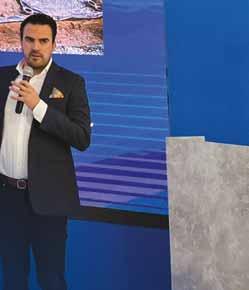
contributor. However, it also highlights the adverse impacts the sector has on the environment, as one generating some 30% of the EU's annual waste and contributing significantly to its domestic carbon footprint and emissions.
The construction industry is a major economic driver; in the EU alone, 25 million people are employed across five million companies, according to data from the revised CPR. So, when the COVID-19 crisis gripped economies and construction output fell to some of its lowest-ever levels, it was no surprise that robust recovery plans with a clear focus on investments in infrastructure were announced by nations around the world to rebound and stimulate economic growth.
However, the cost of raw materials and their availability remained a deepening challenge for the sector.
Materials shortages and their rising costs are not entirely symptoms of the pandemic, but they have been exacerbated by it and have become more acute, according to CDE's business development manager for the DACH region, Christoph Baier.
"Every day we continue to extract our fastdepleting natural resources to support rapid urbanisation and our modern, technological lifestyles,” says Baier. “Essential to this is sand, the second-most consumed natural resource after water and the most consumed solid material on earth."
In April, the UN Environment Programme (UNEP) published 10 recommendations to avert the impending sand crisis. It referenced how the use of sand, gravel, crushed stone and aggregates has tripled in the last two
decades, reaching an estimated 40-50 billion metric tons per year (UNEP 2019).
While COVID-19 economic-recovery packages may help to stimulate growth, Baier says they must be conditional on building back greener, more sustainably.
A circular approach is the only answer, Kelly corroborates.
"It can be the means to equip us with the resources needed to supply a sector charged with a key role in the economic recovery while addressing our collective environmental footprint by reducing waste-to-landfill volumes and extending the lifespan of precious natural materials,” he adds. “All the while continuing to supply a resource-intense sector with the materials it requires; materials often trucked out of our urban centres where they are needed most."
Kelly says the technology needed to extract recycled sand and aggregate resources from CD&E waste that are equivalent to their virgin quarried counterparts is already in operation throughout Europe.
CDE says it supports materials processors to realise the value locked in CD&E waste. Using innovative wet -processing technologies that scrub material, float off lightweights (demolition debris) and classify end products, this waste stream can be repurposed to produce washed materials free of contaminants and suitable for use in highvalue construction projects.
To date, CDE solutions have supported companies around the world to divert over 100 million tonnes from landfill.
"These are far from 'alternative' materials," Kelly explains. "Many material processors utilising CDE technology are successfully producing CE- and BSI-certified concrete products, including competitive concrete for non-structural – but still highvalue – construction projects, with some applications successfully achieving beyond C45 spec."



backdrop of the COVID-19 pandemic and continued rises in the cost of raw materials, these issues have been heightened and highlight the urgent need to radically adjust how we utilise the resources around us in a more circular fashion."
Finland-based aggregates equipment company Metso Outotec is in agreement that there is an imperative need to give new life to construction waste. It says legislations around the world are calling for more recycling of construction and demolition waste, and adds that re-using crushed concrete instead of natural rock and recycling metal saves both the environment and the constructor resources.
Pasi Tulonen, product manager of the Lokotrack contractor line at Metso Outotec, explains that the teardown of structures such as demolished buildings, old roads or bridges creates the opportunity of granting a new life to these materials through recycled aggregates.
essential that the units are designed to handle a variety of materials included in the recycled waste while separating the valuable metals with magnetic separator as well as lightweight materials from screened aggregates with a windshifter.
He adds that different products fit better for different types of waste. For instance, if you still have a great mix of materials after crushing, Metso Outotec mobile screens such as Lokotrack ST2.3, ST2.8, Nordtrack S2.5 and S2.11 are ideal for the job, as they are designed to process any type of concrete, asphalt, or slag.
“Our Lokotrack LT1213S mobile impact crusher offers a variety of features for recycling applications and has an integrated screen, which has made it a very popular solution for recycling applications as it provides great results,” says Tulonen.
Metso Outotec customer Joona Ahonen, of Ahosen Palvelut in Finland, comments on its deployment of an LT1213S impactor crusher: “The most important thing for generating profit will be that the machine continues to work with no sudden shutdowns. With the new Lokotrack, we can crush demolition concrete and asphalt, and produce good volumes of clean grades that meet the customers’ needs.”
Swiss-based global building materials and aggregates group Holcim has launched its upgraded 2030 climate targets, validated by the Science Based Targets initiative (SBTi), in line with its sector's new 1.5°C sciencebased framework. With these upgraded targets, Holcim confirms its commitment to decarbonise building in line with the most advanced science.
Luiz Amaral, CEO of the Science Based Targets initiative, commented on Holcim’s move: “This company is setting an example for the rest of its industry, and I urge others in its sector to set their own targets too."

DA Mattsson, based near Stockholm in Sweden, diverts almost 100% of its incoming CD&E waste from landfill through its CDE wet-processing operation. The company produces high-quality sand and aggregates that meet EN 12620 specification, and it supplies these concrete materials to the Stockholm construction market.
"We are faced with a myriad of challenges,” Kelly says. “Set against the


“After a selective demolition has taken place, instead of dumping the concrete into a landfill, it is possible to crush the waste material in order to give it a new life,” Tulonen says. “We in Metso Outotec have decades of experience in crushing and screening. We have machines that are designed to process construction waste into re-usable aggregates, these are mobile impact and jaw crushers, as well as mobile screens.”
Tulonen says that using the right crusher, depending on the materials that need to be processed, and sorting them accordingly afterwards are crucial exercises for a successful recycling operation. To succeed in the crushing operation, for instance, it is

Jan Jenisch, CEO Holcim, said: "At Holcim, we are committed to decarbonising building for a net-zero future. When I see the thorough decarbonisation plans we are deploying across our business, I am confident that we will decarbonise building at scale.”
In its new 2030 targets, Holcim upgraded its target to reduce scope 1 and 2 emissions per ton of cementitious by 25% by 2030 from a 2018 base year. AB



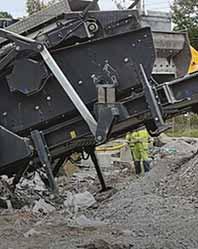
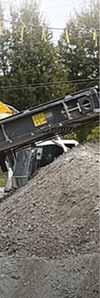

Barbara Gregorio, divisional product marketing manager Innovative Energies and Digital Solutions, Atlas Copco Power and Flow, discusses how portable power solutions are part of a wider solutions portfolio helping to achieve more sustainable quarries

Emission norms are changing operations in the entire construction industry, including quarries. On the journey towards stronger compliance with emission standards, the focus is now way beyond only health and safety regulations for operators. While productivity and efficiency remain the key priorities, the need for a balance with more sustainable solutions is now becoming more of a need than an option.
Quarries are evolving
Quarries are buzzing with round-the-clock extraction operations which feed granite and aggregates into the construction and infrastructure industries. When versatile giant equipment operates with high productivity targets and tight deadlines, emission control in mines and quarries becomes a critical focus.




The face of mining and quarrying is changing with a keen focus on contributing towards reduced energy consumption and higher energy efficiency. (Source: The integrated energy and climate change policy laid out in December 2008)
The changing role of construction equipment in quarries

From lighting to pumping to power generation, sustainable equipment profiles are becoming an integral part of the quarry portfolio. A few key ingredients in the sustainability strategy for quarries can include:

to meet their sustainability goals. Hence the push towards electrification in quarries is an important development which can be supported with standalone or hybrid options to cover unpredictable power loads.

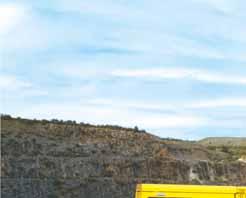
The EU and international emission regulations aim to create a low-carbon and energy-efficient economy with goals to:
• Reduce greenhouse gases by 20%,
• Reduce energy consumption by 20%
• Meet 20% of the EU’s energy needs from renewable sources by 2020

Fuel efficiency: With Stage V and Euro 6 diesel engine regulations, advanced fuelefficient engines are the need of the hour. Forward-thinking construction equipment manufacturers are gearing up to get their machines equipped with the latest technology engines while demonstrating their commitment to a better environmental footprint.
Electric models: With stricter emission regulations, the transition from diesel to low-diesel-consumption equipment to electric models is gaining momentum. Not just electric cars, but also heavy-equipment manufacturers are rolling out electric versions of their earlier diesel-driven models

Hybrid: The new buzzword in the sustainability guide is hybrid. There is a whole new world emerging for hybrid solutions to bring in better energy efficiency with a substantial impact on emission levels. Hybrid power solutions are becoming a crucial asset in the quarry equipment profile so that energy consumption is managed with high efficiency while minimising costs, and quarries are more self-sufficient with clean energy sources.
Digitalisation in quarries: In the quest to achieve sustainability goals, safe operations in quarries remain a priority while bringing in energy-efficient operations.
Digitally connected intelligent machines dot the quarry landscape and reduce downtime while increasing efficiency in




quarry operations. Atlas Copco is launching new intelligent controllers which will optimise energy generation, distribution and consumption through advanced data management to improve machine performance and efficiency.
Pumping solutions: Quarries are prone to flooding, as is the case for abandoned quarries or underground quarries when they are dug below the water table. Managing the water that is accumulated from heavy rainfall and groundwater seepage in quarries is a crucial task which must be done effectively in order to protect construction equipment and allow for operations to continue.
The advanced pump portfolio from Atlas Copco offers electric submersible pumps under the WEDA pump umbrella, which has innovative features including a high performance-to-weight ratio, hardened high-chrome impellers and Wear Deflector Technology, which is designed to minimise wear, ensuring durability for a longer working life. By meticulously redesigning the pump range with the latest 3D modelling techniques, the pump’s efficiency can be increased while lowering unplanned downtime issues in tough working environments like quarries. Quarry owners will less often find themselves forced to replace pumps as service life and repairability are built in from the ground up. The future of pumps will be increasingly sustainable as electrical pumps will further reduce emissions when powered with fossil-free electricity.

technology for smart load management resulting in reduced emissions, better operational efficiency, lower total cost of ownership and higher ROI. When operating standalone in island mode, with zero emissions and zero noise, these modular energy storage systems operate as a primary source of power and accelerate the journey towards clean energy with practically no maintenance.
Energy storage systems: As the use of energy storage systems becomes more popular, new sustainable innovations will continue to bring more energy efficiency in quarries as well. Atlas Copco’s technologically superior Li-ion battery energy storage systems, when paired with its low fuel-consuming generators, redefine hybrid
Design innovation: With skilled design engineers and expertise in both generator and pump product development, a combined green solution engineered to dramatically reduce fuel consumption and CO2 emissions is an expected outcome. New emerging technologies like submersible pumps operating with medium-sized battery packs will transform the hybrid canvas and further reduce the total cost of ownership in quarry operations.
Renewable energy revolution: With renewable energy generation gaining

momentum, solar power has made its way into Atlas Copco light towers and battery pack development. The HiLight S2+ solarpowered light tower taps into solar energy to reduce CO2 emissions by up to 6 tonnes as compared with other technologies. This is a great asset in quarries for night extraction operations where bright and safe light enables operations to continue for 11 hours at a stretch. By reducing electricity costs in quarries with solar-energy options, compliance with CO2 emissions and noise regulations allows work in quarries to carry on autonomous operations all year round when the solar power is adequately tapped.
HVO – biodiesel hydrotreated vegetable oil is a next-generation fuel that further nurtures sustainability goals into construction equipment DNA, reducing the carbon footprint of the machines. This renewable fuel offers a 90% CO2 emission reduction compared to diesel and lasts longer in the tank, which in turn reduces the risk of water ingress, microbial growth, and overall risk of contamination to equipment, making power and pumping operations cleaner and greener.
For Atlas Copco, a quarry is not just a pit in the ground. It is a highly productive worksite which plays a crucial role in core infrastructure development such as roads, metros, expressways, airports, and highway expansion with its aggregate output. As quarries aim to complete the production cycle with as low as possible carbon footprint and with high productivity outcomes, Atlas Copco will focus on continuous innovations in engines, fuel, renewable energy, product design and other ways to calibrate a better balance between energy production and consumption.
With the ever-evolving new, clean energy technologies from Atlas Copco’s generators, pumps and light towers, the journey towards more sustainable quarries is better defined and more achievable.
Atlas Copco is committed to contributing to low-carbon emissions with state-of-theart advanced equipment serving various worksites, including quarries. AB
Tower lights and mobile charging systems can be valuable equipment for quarry operators, especially those working in more remote areas. Guy Woodford reports
Pilot Crushtec has enjoyed considerable success with its Generac mobile tower lights since introducing them to the South African market more than a decade ago. The tower lights have found favour with customers across a range of industries, including quarrying, mining and construction, and units are now operating throughout the southern African region, as far north as the Democratic Republic of the Congo (DRC).
“Pilot Crushtec, of course, is best known for its comprehensive range of crushing and screening solutions,” says Fernando Abelho, export manager at the company. “We introduced the tower lights as a diversification from our main product lines and we’ve never regretted the decision. We’ve notched up truly impressive sales, many of them repeat orders from very satisfied customers.”
When it decided to add tower lights to its product range, Pilot Crushtec concluded a partnering agreement with Tower Light, headquartered near Milan in Italy, one of Europe’s most successful tower light manufacturers. This company has since been acquired by US-based Generac, but Pilot Crushtec is still supplied from the Italian factory.
“The quality for which Tower Light was renowned has continued under Generac which has further developed what was already an outstanding product range,” says Abelho. “The Generac diesel-powered tower light is a truly premium product which is very compact, ultra-safe to use and extremely economic to operate. The attention to detail can be seen everywhere in the machine. The electrical wiring, for example, is all

all-in-one control panel has been developed by Generac specifically for use in light towers. In addition, all the units come with liquid containment tanks to prevent environmental contamination.”
While Generac has a very extensive range of tower lights, Pilot Crushtec focuses on a
single model, the VTevo, available in two variants, one equipped with a Kubota watercooled engine and the other with a Yanmar air-cooled engine. Standard features on both machines include an earth spike, a 4kg fire extinguisher, and the necessary switchgear to allow connection to a mains electrical supply when available. A low-speed, singleaxis towing trailer allows a high degree of mobility on site.
“The two variants both offer 4 x 320W energy-saving LED floodlights, able to illuminate an area of up to 4 500m²,” says Abelho. “The VTevo-Kubota, however, has some additional features that the VTevoYanmar lacks. These include a day/night sensor and a GTL-01 controller which provides a programmable stop/start, maintenance alarms and additional safety and protection features.
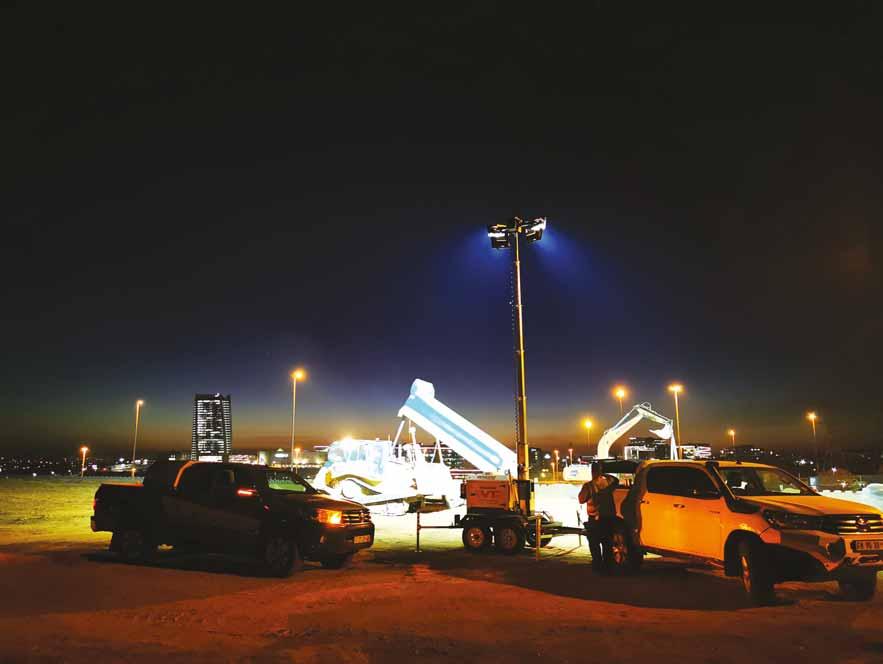
“We find that some customers prefer the lower spec VTevo-Yanmar as it is more competitively priced, and they feel they don’t need any high-tech features. Many others, though, opt for the VTevo-Kubota. They find the programmable stop/start to be indispensable and a great time-saver.”
Abelho also stresses the energy-saving aspects of the VTevo. “The G4 LEDs used are industry-leading and have a life expectancy









of 50,000 hours. They allow up to 220 hours of runtime on a single tank of fuel. Their efficiency is such that they can save up to 75 % of the fuel that traditional towers equipped with metal halide lights use, at the same time reducing carbon emissions by up to 10 tonnes per year.”
During Deutz’s recent Deutz Days showcase event in Germany (21-22 October 2022), the drive specialist presented its nextgeneration PowerTree mobile charging system, which can be used in the absence of any power infrastructure by customers including quarry operators.
The latest PowerTree version offers attractive features for Deutz customers, including an improved design that makes the 10ft container easier to transport. It is now also possible to scale the battery capacity, allowing for optimal adaptation to the customer’s technical and commercial requirements.
Doosan Portable Power (DPP) has launched its new quarryingcompatible G100 Stage V-compliant generator. Providing a prime power output of 100kVA, the new unit is powered by a Cummins F3.8 82kW diesel engine. Despite featuring an identical footprint to its predecessor, the Stage V G100 offers improved performance in most areas, including customer connections, autonomy, fuel consumption and noise levels. Thanks to its Cummins engine, service intervals have been extended to 1,000 hours and the risk of engine issues at low loads –a common issue in the rental market – is said to have been eliminated. The G100 is also compatible with hydrotreated vegetable oil (HVO), also known as renewable or green diesel, further reducing emissions. AB
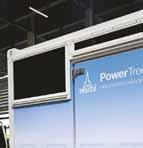




Leading off-highway engine manufacturers have made sustainability a priority alongside the renowned high performance and efficiency of their solutions. Guy Woodford reports
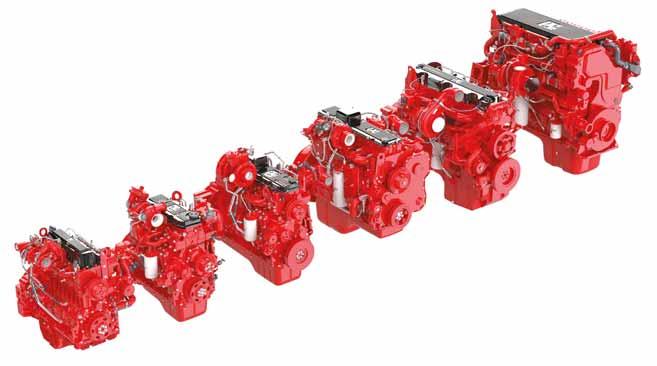
Cummins has been at the cutting-edge of power solutions for over a century.
Moving forward, Steve Nendick, Cummins’ marketing communications director, notes that the US off-highway engine major has a two-pronged strategy: to continue to advance internal combustion engine technology with further advancements in performance, efficiency, and compatibility with cleaner fuels; and to innovate zeroemissions solutions like hydrogen fuel cell and battery technology.
“For construction and aggregates markets, the diesel engine will remain the go-to choice for the majority of machinery due to lack of infrastructure in electric charging and hydrogen supply,” explains Nendick. “While this alternate technology and infrastructure is being developed, Cummins can help operators now with solutions that reduce overall environmental impact of their operations. As well as reducing emissions, they will maximise the efficiency and performance of their machines and cut running costs. Operators can continue to use a tried and trusted power solution.”
Nendick says the latest generation of Cummins Performance Series Stage V engines can satisfy the duty cycles of a variety of construction demands, whilst generating near-zero NOx and particulate matter emissions.
Significantly, Nendick notes that Cummins Performance Series range has high power and torque for engines of their size. This means that they can replace Cummins and competitive engines of higher displacement without impacting productivity. It delivers a lower cost installation for the manufacturer

and a more efficient operation, with less fuel use and lower CO2 emissions for the end user. Nendick stresses that servicing costs are also reduced with less oil and filters needed.
“Each Performance Series engine can be matched to the OEM’s machine electronically. Cummins’ proprietary software calibration is tailored to the exact operational needs of the equipment to provide the ideal solution.
“The range is available from 3.8- to 15-litre displacement with power from 55 – 503kW. The engines’ up-to-nine-litre displacement are integrated with Cummins Single Module after-treatment systems
to meet the Stage V near-zero emissions levels without the need for cooled exhaust gas recirculation (EGR). This makes the engines lighter and more compact, and lower in weight, driving further efficiency and environmental benefits.”
Nendick highlights that ‘Stop-Start’ capabilities can be combined with the B6.7 Performance Series to lower fuel consumption by up to 10%, cutting CO2 emissions and overall operating costs, whilst also minimising on-site exhaust emissions and noise.
To integrate Stop-Start technology effectively, Cummins engineers work jointly with customers to tailor engine-control software to the OEM’s machine-controller software. The OEM controller observes the machine operations and relays them to the engine-control module when it is appropriate and safe for the machine to shut off. The engine controller monitors working parameters such as coolant temperature, intake manifold temperature, engine load, and fan operation to make sure it can shut down.
Due to this tailoring per application, with a limited number of stop-starts allowed per hour, this technology provides on-site emissions and sociability benefits without impacting durability.
Nendick continues: “Cummins has recently announced collaboration with a number of Telematic Service Providers (TSPs) to enable customers to remotely access their engines through Connected Diagnostics. These include Topcon, Trimble, TelliQ, Elevat and Saucon with more to come.
“Cummins Connected Diagnostics works by wirelessly connecting engines, allowing for constant monitoring and diagnosis of operating behaviour and potential causes of engine faults. Owners are then able to make informed decisions and take adequate actions as they can suggest adapting how equipment is being used or make pre-emptive repairs to prevent extended periods of downtime. This capability assists in improving operating performance, boosts asset utilisation and maximises uptime, increasing efficiency while also reducing overall costs.

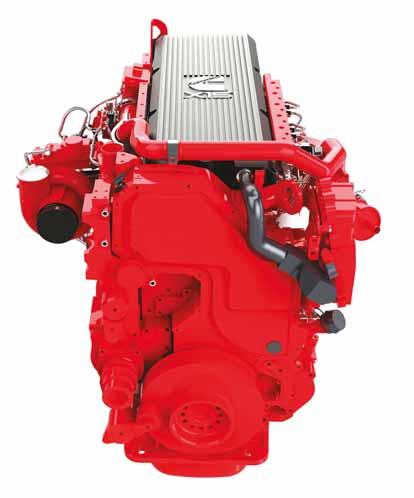
“Working in tandem with Cummins technology, Elevat’s Machine Connect makes it simple for off-road equipment OEMs and fleet managers to gather and analyse data to
off-highway engine. This means that the full Performance Series from 3.8 litres up to 15 litres can utilise this low-carbon fuel.
Often described as a renewable diesel or green diesel, HVO is collected by processing lipids such as vegetable oil, tallow, or used cooking oil. It delivers up to a 90% reduction in greenhouse gas emissions compared to diesel ‘from well-to-wheel’. Sulphur-free and oxygen-free, it does not require any engine modifications for it to be utilised, with very little impact on service intervals.
“Using equipment installed with HVO-ready Cummins Performance Series engines is an easy, and economic step that allows customers to reduce their greenhouse gas emissions, with minimal impact to operations and processes,” explains Nendick.
Nendick emphasises that Cummins is a market-leading company progressing future energy solutions and developing innovative products to the market, spending over US$1bn each year on research and technology. This, he says, is evident in the additions of HVO and Stop-Start capabilities for the Performance Series, but also in the
Volvo Penta has taken another step on its journey towards creating a sustainable industrial future with the unveiling of its dualfuel hydrogen engine at bauma Munich. By using hydrogen as a renewable fuel source, the engine – which is an evolution of the company’s proven D8 model – will reduce CO2 emissions by up to 80%, without impacting power or performance.
The engine operates in a similar way to the conventional D8 model but uses mainly hydrogen instead of diesel. If hydrogen is not available, the engine can continue to run on traditional fuel, safeguarding productivity and uptime. This means that with dual-fuel technology, assets and business operations can be future-proofed – despite the fact there is not full coverage from a reliable hydrogen infrastructure in place today.
“The new Volvo Penta dual-fuel hydrogen engine offers customers a low-carbon interim solution before suitable zero-emissions alternatives become viable,” explains Anders Wernersson, product manager for the dualfuel hydrogen engine. “It delivers the same power and torque curve as a regular diesel engine but with significantly lower CO2 emissions. The technology is relatively simple and can be installed with minimal disruption, so we see this as being a cost-effective and robust solution for customers in a variety of applications – including construction, quarrying, and mining – who are looking to


The first engines will be working in end customers’ machines in Europe in 2023 as part of a market pilot project, which will be followed by small-scale production. It will be a stepwise introduction based on market and customer demand and there will be a focus on the fit between the technology and customer needs, ensuring it makes sense to choose a dualfuel powertrain.
“Collaboration and partnerships are essential to facilitate the transformation towards more sustainable power solutions,” says Wernersson. “This close partnership approach is a cornerstone of Volvo Penta’s long-term decarbonisation and business strategy. We work closely with our customers and partners to create tailored solutions based on their requirements. As part of the Volvo Group, we are in a unique position in that we can leverage proven technology and competence from Volvo Trucks, Volvo Buses and Volvo Construction Equipment. We combine this with our customer, market and application knowledge, allowing us to optimise and adapt our designs for a specific vehicle, considering the duty cycles, climate and environment it will operate in.”


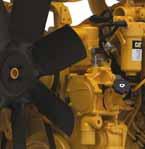



The new, eight-litre model has been designed to reduce emissions by using a renewable, fossil-free fuel source, therefore it is recommended that customers will use green hydrogen to power their equipment. Green hydrogen is a renewable energy, created by the electrolysis of water using sources such as solar, wind and waterpower to create a fully-carbon-neutral, hydrogenproduction cycle.
The new, dual-fuel hydrogen-powered solution will help Volvo Penta on its way to reaching its ambitious commitment to the Science Based Targets initiative (SBTi), where the company aims to reach net-zero-valuechain emissions by 2040.
As part of the company’s enterprise strategy to support customers during the energy transition to a lower-carbon future, Caterpillar has highlighted its development of 48-volt, 300-volt, and 600-volt batteries for the off-highway industry.
Leveraging expertise across Caterpillar’s global network of technical centres in the US, UK, China and India, the programme focuses initially on battery solutions for equipment used predominantly in industrial applications.
The battery range uses lithiumion technology and features a modular design to optimize performance and packaging. Furthermore, it has been engineered with sustainability in mind throughout its lifecycle, with the potential to reuse and recycle at the end of life.
The development programme also encompasses inverters, motors, electronic

controls, digital services and other critical technologies to deliver the performance, reliability, durability, maintainability, and long-term value needed for equipment buyers working in harsh operating environments.
Caterpillar showcased prototypes of its battery technologies at bauma in Munich, Germany (24-30 October 2022).
“Caterpillar has demonstrated a longstanding commitment to sustainability through improvements in our operations and by helping our customers achieve their climate-related goals,” said Steve Ferguson, senior vice president Caterpillar Industrial Power Systems. “The announcement of our battery programme is our latest step in combining a wide-ranging inventory of innovations with extensive knowledge of the off-highway industry to offer solutions for a range of power needs, application types, duty cycles and operating environments.”
Perkins’ up to 430kW 12.5-litre
2406J-E13TA industrial diesel engine

Caterpillar has committed to 100% of its new products through to 2030 being more sustainable than the previous generation, which is reflected in Caterpillar’s line-up of industrial-power solutions and integrated services finely tuned for owners of third-party equipment powered by Cat engines.
“Improved sustainability is a journey, not a destination, and one size doesn’t t all in determining the appropriate power solution for equipment owners,” Ferguson said. “Our offerings can help customers and end users start improving the sustainability of their operations today through high-efficiency engines, fuels and digital solutions now available for the jobsite, by extending value and reducing waste over the lifecycle of equipment they already own, and by powering the next generation of equipment with innovations precisely gured for the jobsite.”

At bauma 2022, Caterpillar also showcased its 100kW Cat C3.6 industrial power unit and C7.1, C9.3B, C13B, and C18 industrial diesel engines. All meet EU Stage V and U.S. EPA Tier 4 Final emission standards while delivering claimed superior performance and low operating costs.
Perkins showcased at bauma 2022 Munich how it continues to invest in new engine technologies, including dual-label certification for EU Stage V and U.S. EPA Tier 4 Final. By what the company says is its optimising of the efficiency of the entire engine system from the air intake to the end of the exhaust pipe, Perkins has developed a full range of engines from 0.5 to 18 litres and 8.2 to 597kW with an integrated suite of advanced technologies. The units not only reduce GHG emissions, but also deliver significant improvements in power density, performance and operating efficiency.

The emissions of carbon dioxide and other greenhouse gases associated with these engines can, says Perkins, be reduced by up to 85% using renewable, lower-carbon intensity fuels derived from sources including planted crops (soy, palm, rapeseed, etc.), used cooking oil, animal fat, biomass, algae, and others. Every industrial Perkins engine from the 400 Series through the 2800 Series can use low-carbon-intensity fuels that meet the leading industry diesel fuel specifications.
Additionally, Perkins, which has a customer base of more than 800 original equipment manufacturers (OEMs), offers a powerful and growing portfolio of connectivity solutions that can help OEMs promote the optimal, sustainable performance of diesel engines. Available as a standalone service from Perkins or easily integrated with OEM fleet management offerings, connected engine capabilities deliver timely insights through a customisable dashboard of performance, fuel and oil consumption, and other vital engine data points that can maximise the
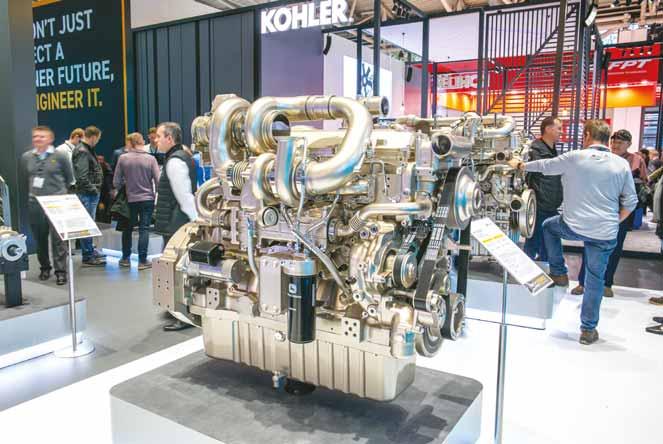
uptime of Perkins-powered machines and fleets.
These connectivity offerings are seamlessly integrated with expert maintenance and service capabilities from the Perkins global distributor network to prompt the proactive diagnosis and resolution of engine issues, helping technicians get the job right first time to minimise downtime and repair expenses.
For example, the free Perkins My Engine app has been downloaded more than 100,000 times since its introduction in 2017. It reduces paperwork and improves productivity by providing service reminders, electronic service logs, service publications, quick links to distributors, and simplified sharing of engine data for customers, which is especially useful for rental companies.
In an increasingly connected world, OEMs are looking for ways to leverage the large amounts of telematics data being collected every second.
Creating actionable opportunities to strategically use these thousands of data points is one of the pressing challenges facing the off-highway industry as more OEMs integrate telematics systems into their equipment with the goal of better serving end users. The off-highway vehicle telematics market is projected to have a compound annual growth rate of 15% from 2022 to 2032, according to a report by Future Market Insights.
John Deere has found a way to address this challenge with Connected Support.
Enabled through John Deere remotemonitoring and diagnostic services, Connected Support helps increase efficiency, profitability, and productivity by monitoring equipment health and triggering predictive alerts to dealers so they can proactively manage parts replacement and schedule maintenance to improve their customers’ uptime.
Connected Support leverages a suite of dealer and factory tools including the ability to remotely monitor fleet health, diagnose
machines, and program software. The Connected Support technology allows both dealers and end users to shift from a reactive maintenance mentality to a proactive approach.
John Deere is expanding its future telematic technology offerings to John Deerepowered OEM equipment through Connected Support with no subscription fees. Leveraging telematics will help ensure that OEM machines powered by John Deere engines are kept in peak operating condition, resulting in improved equipment uptime, and offering more insights into equipment performance.
Meanwhile, John Deere Power Systems (JDPS) is introducing two next-generation diesel engines, the JD14 and JD18, which have been designed from the ground up. These bauma 2022-showcased engines have capacities of 14 litres and 18 litres respectively and meet Stage V and Tier 4 Final emissions requirements for Europe and the US.
Nicholas Pfeiffer, an engine specialist from the company, said: “The 14 and 18 are the
next generation of engines from us. They’ve been developed with a focus on serviceability and have the latest diagnostics.” Pfeiffer explained that the diagnostics ensure that the engines offer predictive maintenance capabilities, catching potential faults before they develop and making significant reductions in maintenance costs while also preventing unplanned downtime. He said, “We have our telematics gateway and if you opt in, the dealer is able to call you even before you know there’s an issue.”
Meanwhile, the wiring harnesses are all external to the engines making them easier to maintain and less vulnerable to damage. Customers are also able to select different fuel and oil filter locations to best suit the installation. Pfeiffer added that the simplification of the after-treatment package for the JD18 engine offers significant benefits also, with fewer sensors required and a further reduction in maintenance costs. These engines are biofuel capable, and Pfeiffer added, “We are working on HVO.”
US off-road engine manufacturer Kohler has completed a recent 155,000m² expansion of its North American manufacturing facility in Mosel, Wisconsin, ahead of its 150th year in business in 2023.
The company has set out its new strategy toward a more sustainable future, revealing its long-term plan and next steps to transform the group from a power producer to an energy supplier. The company says the unveiling of this new strategy comes at a momentous time for the engine industry.
Kohler’s strategy incorporates alternative fuels, electrification and hybridisation to reduce engine size or achieve zero emissions during operation, and hydrogen as a potential green-source fuel.
The manufacturer recently acquired electric vehicle and hybrid applications company Curtis. Kohler says the acquisition expands and diversifies its product portfolio, leveraging Curtis’ expertise in electrification,

NNK's




The Eastern European aggregates industry has experienced a very challenging time in recent years, with severe COVID-19-induced disruption followed more recently by the fallout of Russia’s war with Ukraine. Guy Woodford and Eugene Gerden report
The Eastern Europe construction outlook is increasingly gloomy for 2023 amid mounting headwinds, says GlobalData, a leading data and analytics company.
Construction output in Eastern Europe is forecast to contract by 2.5% in 2022, before declining by a further 2.7% in 2023. The decline in activity is due to the heightening risk of recession and tightening monetary policy across the region, coupled with low investor confidence and high construction costs stemming from the Russia-Ukraine conflict, reveals GlobalData.
Joel Hanna, economist at GlobalData, comments: “The European energy crisis is creating a very challenging environment for construction companies in Eastern Europe. In addition, slowing economic growth and an increase in borrowing costs will weigh heavily on the residential, commercial and industrial sectors, and continue to dent investor confidence.
“As a result, the overall construction activity over the coming quarters is likely to be impacted by stalling progress on current projects as well as a lack of new starts due to subdued investment. On the upside, EU funding, including the NextGenerationEU [pandemic]recovery fund, could help to partially offset the rise in borrowing costs in some markets and support the continuation of activity in transport and energy infrastructure development.”
GlobalData’s report, Global Construction Outlook to 2026 (Q3 2022), reveals that the
construction output in Russia – the region’s largest market – is forecast to expand marginally by 0.6% in 2022 before posting a sharp contraction of 6% in 2023. The second-largest market, Turkey, is expected to contract by 8.1% and 3.3% in 2022 and 2023, respectively. Elsewhere, Poland and the Czech Republic are projected to grow by 4.9% and 2.9% in 2022, respectively, before posting respective contractions of 2.8% and 2.4% in 2023.
Hanna continues: “Owing to strong growth in the first half of the year in some of the major markets such as Russia, Poland, and the Czech Republic, the annual growth rates for 2022 in these markets are expected to be positive, despite a significant fall in the activity in the second half of the year. However, the impact of tightening monetary policy, low investor confidence, and sustained upward pressure on construction costs will be reflected in relatively sharp contractions in 2023.”
In the case of Russia, the growth forecast for 2022 has been revised upwards from 8.5% due to unexpectedly strong levels of activity since its invasion of Ukraine. However, weakening public revenue owing to the depressed export activity is expected to weigh heavily on output over the next year.
Hanna concludes: “Following a weak performance in 2022 and 2023, GlobalData expects construction activity in Eastern Europe to rebound in 2024 reaching a growth rate of 3.3%, before averaging a growth of 4.3% in 2025 and 2026. Output
levels are now expected to remain below pre-pandemic levels until 2025 owing to current headwinds.”
Aggregates Business’s St Petersburg-based freelancer, Eugene Gerden, reports that the 720mn tonnes/year Russian aggregates sector faces the deepest crisis in its modern history.
In a piece filed for this magazine this autumn, Gerden says: “Probably one of the biggest problems for them [Russian aggregates producers] is currently related to logistics and financial issues. Many local aggregates producers face serious problems associated with the delivery of new equipment and machinery for their plants and quarries, as well as transferring payments for it. Most local industry analysts expect the current situation to continue to deteriorate, as most of industry players are unable to continue the modernisation of their fixed assets, while almost all Western machinery suppliers and producers have suspended their supplies to Russia.”
Gerden says that there is a strong possibility that the international sanctions imposed on Russia following its invasion of Ukraine will put an end to the further growth of the country’s aggregates sector “for years to come”, after its steady growth since the start of the 21st century. “They [the sanctions] will also affect all the planned new projects in the industry, including those which involve the discovery and development of new [aggregate production] fields. Most industry analysts expect implementation of these
plans will be impossible amid the current economic conditions in the country and the ever-growing sanctions pressure.”
Most aggregates production in Russia is traditionally concentrated in Russia’s northwestern district (in and around St. Petersburg), with central Russia a lesser production hub. Before the Russia-Ukraine war, Gerden notes that the Russian aggregates industry consisted of more than 1,000 enterprises, but the continuing conflict has seen these numbers decline “significantly”. “This is mainly due to the market withdrawal of many producers, primarily those of small and medium size,” he explains.
While a long way behind Russia, Europe’s biggest annual aggregates producer, Poland, is still among the bigger national producers in Europe at around 270mn/tonnes a year, a similar level to the UK’s annual output.
Holcim recently completed the acquisition of Izolbet, one of Poland’s leading players in the specialty building solutions market.
Izolbet has delivered double-digit growth in sales and EBITDA over the last three years. The acquisition will strengthen Holcim’s footprint in the highly attractive market for renovation, thermal insulation and finishing and will complement Holcim’s recent investment in a new production facility for dry mixes in Kraków.

Miljan Gutovic, Holcim region head EMEA, said: “I warmly welcome all Izolbet employees to the Holcim family as another step in our expansion of Solutions & Products, advancing Strategy 2025 –Accelerating Green Growth. Specialty building solutions have been a key focus for expanding Solutions & Products in Europe, notably with the recent acquisitions of PRB Group in France as well as Cantillana and PTB-Compaktuna in Belgium. I’m excited to be welcoming all of Izolbet’s employees into the Holcim family to unleash our next chapter of growth together.”
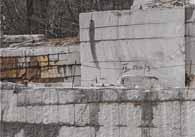
Izolbet employs around 170 people and has four production plants in Budzyn´, Gostynin, Kleszczów and Chmielów. Its products are sold through distribution sales channels across the country, with most of its business in the high-growth repair & refurbishment market.

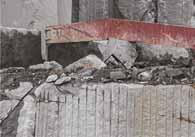
“I’m excited to be welcoming all of Izolbet’s employees into the Holcim family”
“In the last decade, the Polish aggregates market has been increasing,” says Machniak. “It was not the same high-level dynamics rst years after Poland joined the EU (2004-2011). Two-thirds of the Polish aggregates production is sand and gravel, the other third is crushed aggregates. The average annual mineral extraction of aggregates in this period was approximately 260 million tonnes plus about 10 million tonnes of aggregates produced as different types of minerals. However, the sold production was lower because for sand and gravel, it is estimated that about 30-40 million tonnes of the sand proportion, after sifting out the gravel part, goes back to the
equipment manufacturer (OEM) with a strong market share in Poland.
Speaking to Aggregates Business, Jarosław Wojtanowski, quarry and aggregates market manager at Bergerat Monnoyeur (Poland), Caterpillar’s Polish market dealer; and Lukasz Machniak, board director of the Polish Association of Aggregates Producers, and a lecturer at the Mining and Metallurgy University of Krakow, gave their thoughts on the Polish aggregates and quarrying sector.



“During this period, the number of active mineral extraction quarries did not change cantly. There were on average 330 solid rock quarries and 2,500 sand and gravel quarries. For sand and gravel, one could speak of a deconcentrating of quarrying and production sites, i.e., even coverage of the country by producers of these aggregates. At the same time, the quality of the deposits was differentiated expressed by the sand content, which was the most favourable in the southern district (approx. 50-60%), and the least favourable in the central districts (80-100%). Overall, the country's quarries’ average sand content is about 70%, which proves the dominance of the sand percentage. In the case of crushed aggregates, it can be said that the extraction is concentrated in two out of 16 districts. About 75% of crushed aggregates are extracted and produced in the Dolnos´la˛skie and Swie˛tokrzyskie districts.”
Machniak says the COVID pandemic distorted the relationship between Polish


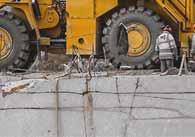
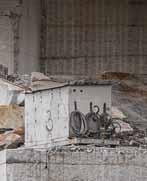


aggregate production and GDP. “From an aggregates market point of view, it is important that GDP is driven by investments, and not, for example, by private aggregate consumption or exports. However, looking at this relation historically and in the longer term, according to the research conducted at Krakow Mining and Metallurgy University (AGH), the positive signals for the aggregates market show when the GDP growth is at least 3% year-on-year.
“The years 2020-2021, especially 2020, when we faced the COVID-19 pandemic, raised many concerns about the situation on the aggregates market. Despite a 2.5% decline in GDP, it was possible to keep investments at a sufficiently high level. This means the aggregates market was stable with slight drops of around 3% compared to 2019. The year 2021 saw the return of the 2019 production volumes. It was a record year in terms of volume of (residential) construction, which generated a considerable demand for gravel and grits. The record levels were the result of postponing investment decisions from 2020.”
Machniak says that in 2021, domestic producers of natural aggregates delivered about 85-90 million tonnes of crushed aggregates, 45-50 million tonnes of gravel and 100-110 million tonnes of sand. In addition, approximately five million tonnes of aggregates were imported, mainly from Scandinavia. We must also mention recycled and industrial (post-metallurgical) aggregates. Machniak says there is no reliable information on the volume of their production of recycled aggregates.
“The greatest demand is for sand. It is estimated that about 100-110 million tonnes are used each year and 50 million tonnes






“The repeatability of the cycles allows us to work out the cost per hour of a working set of machines”
of aggregate mix,” he continues. “Such a high demand for sand and aggregate mix is for use in road construction (road and motorway network), which is approximately 60% complete, as well as for road investments carried out by local governments. For gravel aggregates (gravel), demand is generated mostly by producers of concrete products, including ready-mixed concrete. In recent years that demand was estimated at about 45 million tonnes/year.”
Asked about commercial opportunities for Caterpillar in the Polish market, Wojtanowski says: “In quarries, machines work in cycles. The repeatability of the cycles allows us to work out the cost per hour of a working set of machines and compare their efficiency to provide a cost per tonne of material from the loading face to the primary crusher hopper.
“The cost per tonne is one of the most important parameters for our customers. They know that with Cat machines they can achieve the lowest cost per tonne thanks to high productivity, durability, and uptime. The Total Maintenance & Repair contracts (TM&R) we provide include the regular maintenance, inspections, and preventive repairs of Cat machines. Bergerat Monnoyeur is increasingly delivering more of those solutions and our Service Department is well prepared to support the demand.
“Another important parameter in the cost per tonne is fuel consumption and fuel efficiency (litres per tonne). In quarry applications, Cat machines are extremely fuel-efficient. Bergerat Monnoyeur (Poland) together with Caterpillar can guarantee a maximum fuel consumption for each machine in a specific application with specific performance and idling ratio.”
Commenting on specific large construction projects fuelling Polish aggregates demand, Machniak says: “The largest investment is undoubtedly the Central Communication Airport. However, there is considerable resistance in the towns and villages both with the airport itself and with the railway connections and this may have a significant impact on the original construction schedule. The investment may extend over time, which means that the generated annual demand for aggregates will not make a significant difference on the aggregates market. For the aggregate market it is important that the investment in the basic network of motorways and expressways continues and that there is investment stability from local government.
“Road construction is estimated to use approximately 110-120 million tonnes. Building construction is in second place, generating a demand for about 60 million tonnes of aggregates, only for the construction of buildings.
“We are at the beginning of the new EU financial plan. Historically, we need around two years to achieve a good level of spending. So, the visible effects are not expected until around 2024. In the present situation, the resources from the NextGenerationEU (NGEU) - in Polish KPOKrajowy Plan Odbudowy) – are an absolute priority.”
Looking ahead to the next 18 months and the major developments set to impact on the Polish quarrying and aggregates sector, Machniak says: “The situation is dynamic and basically unpredictable. It is difficult to talk about forecasts. It could negatively impact the production of concrete (ready-mix).
Source:
“This year and 2023 will be difficult for aggregates producers because of the war in Ukraine. Producers face rising production costs and a declining demand. The price of fuel and energy is breaking all records, and this will undoubtedly impact the economic situation. Apart from the high prices, the fluctuation is disturbing and makes it impossible to plan and evaluate deliveries with future deadlines. The greatest concerns
are related to continuing to keep large infrastructure investment projects going. Those projects represent a significant part of the portfolio for aggregates producers. We are also starting to notice a slowdown in home building and general construction. In the first half of 2022, it was approximately down by 20% than in the corresponding period of 2021, but at a comparable level to 2020 and 2019.
“Currently, the transport of coal from ports and agricultural products from Ukraine by train is a priority. In the previous years, around 45 million tonnes per year were transported by rail and it therefore raises concerns about the timely delivery of aggregates. At the start of the war in Ukraine, the import of crushed aggregates from Ukraine and Belarus was stopped. The quantities imported in recent years amount to approximately 1.5 million tonnes. However, that can be easily replaced with domestic production. That situation will have no global impact in the aggregate market, however in case of regional market (in Eastern districts) it has forced a change of direction of the supplies.”
Powerscreen, one of the world’s leading crushing, screening, and conveying equipment manufacturers, has appointed IRCAT as its authorised distributor for Romania, an 85mn tonnes/year plus aggregates market.
IRCAT will provide full coverage in this territory including Powerscreen machine sales, spare parts and service support.
Powerscreen, a Terex Materials Processing brand, says IRCAT, which was established in 2003 and is headquartered in Bucharest, has a reputation for providing high performance equipment solutions and professional aftersales support to end customers across Romania.
IRCAT’s Adrian Dragomir says: “For almost 20 years we have continuously grown our business based on high-quality products and strong partnerships. Now we are honoured to represent Powerscreen in Romania. We believe that the high-performance solutions and their corporate culture aligns with our business goals, and that the results of our collaboration will be increasing customer profits and satisfaction.”
In addition to the sale and support of Powerscreen equipment, IRCAT has taken advantage of a flexible stocking line from Terex Financial Services.


construction materials in Czech Republic and Slovakia is steadily growing despite prolonged COVID-19-induced disruption.
Michael Junge, chairman of Czech Republic-based aggregates producer EUROVIA Kamenolomy (part of the EUROVIA CS Group), says that despite the pandemic, 2020 was a record year for the company in terms of sales in the domestic market.
The company is a leading player in the Czech aggregates market, managing 26 facilities, including 21 quarries and two sand pits. Junge estimates the current annual demand for aggregates at 40mn tonnes in the Czech Republic and 28mn tonnes in Slovakia. According to other industry experts, those annual demand volumes are impressive given the toll COVID-19 has had on the neighbouring nations.
Powerscreen and IRCAT executives celebrate IRCAT’s appointment as Powersceen’s authorised Romania dealer
Zväz výrobcov cementu Slovenskej republiky (The Slovak Cement Association), tells Aggregates Business that the country’s cement production is back to pre-pandemic levels.
Many Czech and Slovak aggregates producers expect to see an increase in sales due to new national and regional infrastructure projects that are part or largely funded by the €750bn (€806.9bn as of November 2022 prices) NextGenerationEU recovery fund, designed to help Europe's economies and societies recover from the pandemic.
Despite its geopolitical challenges and amid understandable concerns over how a still-to-be-defeated coronavirus will react to the onset of winter, the Eastern European aggregates sector has some grounds for optimism going into 2023. AB

Looking down from up high at the edge of Carriére des Limites’ Rochefort quarry









The first European installation of the state-of-the-art Metso Outotec HRC 8 high-pressure roll crusher is helping a leading Belgian quarrying company produce high-quality manufactured sand for its diverse customers. Guy Woodford reports
Frustrated with the dust generation and lack of production volume and flexibility of Carriére des Limites’ previous HSI (horizontal shaft impactor) sand tertiary impact crusher, in November 2021 Jean-Marc Fonzé contacted Jean-Philippe Rezette, account manager for crushing and screening at BiA, a longstanding Carriére des Limites’ quarrying plant dealer, to discuss alternatives.
Business at Carriére des Limites’ nearly two-million-tonnes aggregates and sands/ year Rochefort limestone quarry in Belgium’s beautiful Ardennes region was good, but the inefficiencies of its impact crusher had the potential to harm the supply of high-quality manufactured sand to their majority readymixed concrete-producing clients.
BiA had previously supplied Carriére des Limites with six Nordberg and Metsobranded primary and secondary crushers for the company’s limestoneaggregate-product production, and Rezette knew Metso Outotec had just launched the HRC 8 high-pressure roll crusher. He got in touch with Oldemar Meneses, Metso Outotec’s manager of impactor and sand solutions, based at the company’s Mâcon, eastern France facility, and arranged for him to visit Carriére des Limites to discuss the potential benefits of deploying an HRC 8 plant at the Rochefort quarry.
“With our old impact crusher, we were generating around 60,000 tonnes of stone dust waste a year. That is a lot of wasterubbish that we cannot sell,” says Fonzé, director of Carriére des Limites’ aggregates division. “We wanted to find a machine that would work more slowly, generating less dust, and could be easily altered to make






different types of sand or aggregates product.
“We saw the test results from an HRC 8 processing limestone samples, and we trust BIA and Metso Outotec. We know they are serious people and have a long working relationship with them. If other manufacturers proposed this solution, we would not have chosen it.”
Carriére des Limites has had its HRC 8 since early September and Fonzé and Rochefort quarry manager Hugues Antoine say they are pleased with its initial performance.

“The cubicity of the final product and quality of the fines are good,” confirms Antoine. “I like the fact that we can easily adjust the speed and pressure of the [HRC 8] crusher. We are waiting for results from [HRC 8] tests done on our limestone at [Metso Outotec] Mâcon.”
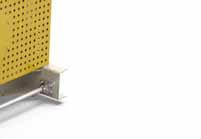

“Before we had the HRC 8 we had to stop production when our four [different product size] stockpiles were full. Now we have a crusher that can more easily switch between processing different sized products to avoid stoppages. As such, it gives more working hours and optimises production, while generating less waste,” explains Fonzé.
Metso Outotec says that its HRC 8 highpressure roll crusher can turn large volumes
of quarry waste into high-quality saleable product. As demonstrated at Carriére des Limites, the model is designed to ensure energy-efficient operation, flexible operating parameters, high productivity, increased availability, rapid installation time, and safe and simple change-out of long-life wear components.
Unlike Carriére des Limites’ previous impact crusher setup, the HRC 8 eliminates the problem of a high-speed rotor generating very high energy and repair costs and unscheduled downtime. Fonzé and his team are finding that the HRC 8 plant offers flexibility to adjust the pressure applied to the feed material, while simultaneously making the product gradation finer or coarser as required.
All this is obtained simply by touching the screen of the HRC 8’s crusher automation technology, the IC80C.
Commenting on the IC80C, Antoine says: “It’s easy for me to use. It gives me a clear on-screen view of the amount of material going through the machine, the production power and speed, and the pressure on the pistons.”
As well as serving its manufactured sand production needs, Carriére des Limites is also finding that the HRC 8 can effectively re-crush its 8x20mm product to achieve high-spec 8x16mm and 2x0mm products. The HRC 8 also gives the company the option to re-crush 2x8mm rock and maximise 2x0mm product as demand dictates.
“The biggest thing for me regarding the HRC 8 is how it performs and wears over time, given the constant stone-on-stone pressure. It is not a big machine,” says Fonzé.
Meneses is quick to reassure him. “Given the low silica content in the material that the plant is working with, and the HRC 8’s lower operating speed, I don’t see any problems with excessive wear.” He adds: “Metso


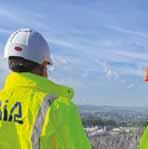
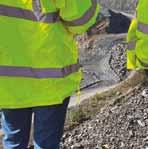

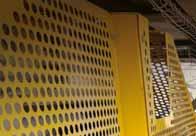


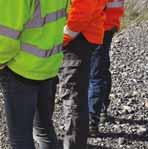

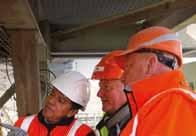









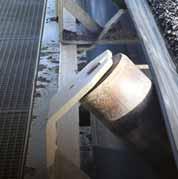















Outotec’s main wear-parts warehouse for Europe is in Belgium. We have other HRC 8 plants being commissioned in Germany and Norway, and all the wear parts for backing up these machines will be stored here.”
Established in 1961 by Jean-Marc’s father, Ronald Fonzé, and his business partner, Antoine Kremer, in November 1989 Carriére des Limites was taken over by Belgian construction materials group Socogetra and French giant Lafarge took over the business, strengthening it through significant capital investment.
In mid-2009, Lafarge sold its shares to the Brussels-based Besix Group. In his leadership role, Jean-Marc Fonzé is also responsible for Carriére des Limites’ two other Ardennes-based quarries.
Originally exploited as marble because it takes a beautiful polish, the blue limestone at Carrière des Limites’ Rochefort quarry is, after crushing, screening, and washing, hugely popular among ready-mixed concrete, road, rail, other public construction works, and asphalt plant customers. Its richness in calcium also allows this mineral product to find, after a fine grinding, natural outlets in agriculture and industry.
Carrière des Limites’ markets are mainly in Belgium (49%) and Luxembourg (40%), and to a lesser extent in Holland (9%) and France and Germany (2%). The company has a turnover of nearly €15 million and employs more than 30 full-time employees.

Commenting on the company’s Luxembourg trading, Fonzé says: “It’s a very small but very rich country. Each year, Luxembourg gains many new buildings. Among the contracts we’ve had there have been supplying materials for developing its
Aggregates Business visited Carrière des Limites’ Rochefort quarry, it was operational 6am to 10pm, Monday to Friday, using a two-shift pattern.
Environmental best practice is a key facet of Carriére des Limites’ quarrying. At the Rochefort site, the company uses a washing plant and filter press, recycling over 90% (350m³/h) of production water and minimising operating space taken up by ponds. In summer, the quarry is 50% solarpowered, and Fonzé is exploring how best to increase the site’s year-round use of the renewable energy.
“I also looked at introducing a big wind turbine here, but we have military aircraft ying in this area, so it’s not possible,” says Fonzé, who says the large installation of solar panels at Rochefort quarry in May 2021 was well timed given the huge rise in site energy costs due to the impact of the RussiaUkraine war.
Given its investment in sustainable production and latest plant technology, Aggregates Business would like to return to Carriére des Limites’ Rochefort site to discover the full impact of the HRC 8 and how Fonzé and his experienced team have built on the quarry’s already impressive operating practices.


Continental launches smart conveyor app in Europe Continental is launching its ‘Make Power Smart’ smartphone app for conveyor belts onto the European market.


Metso Outotec is expanding its cloud-based Metrics monitoring-system portfolio to customers’ stationary screening equipment.
With its 24/7 online monitoring capabilities, the Finnish company says Metrics offers improved safety, increased uptime and throughput, and reduced unplanned maintenance. It enables operators, controllers and service professionals to see real-time analysis of vibrating screen performance and bearing condition. Metrics is designed for intuitive operation. A screen dashboard with OEM insights is designed to make it possible to quickly detect potential issues and take corrective action in time.
In June, Metso Outotec announced a global cooperation agreement with Dynamox, which offers a condition-monitoring platform. Metrics for screens is the first solution utilising Dynamox’s instrumentation that can be complemented with value-added services and remote-monitoring capa-
Haver & Boecker Niagara has unveiled its next-generation Niagara T-Class vibrating screen.
The new design is said to retain the technical benefits the original concentric technology is known for while improving screening uptime and performance with new features. The T-Class provides producers with a costeffective, maintenance-friendly solution to process a wide range of materials within the aggregates, mining, industrial minerals, recycling industries and more.
The T-Class deck frame is now primarily lockbolted rather than welded to provide optimum strength, reliability and safety. Lockbolts are proven to be more effective than welding in the demanding, load-bearing, high-vibration operation of a vibrating screen to ensure the


bilities in the customer’s value chain.
“The customer feedback received has helped us to offer a solution focused on customer centricity and sustainability,” says Jan Wirth, technology director with Metso Outotec’s screening solutions business. “Metrics for screens helps customers to optimise their process, as they can easily see how the changes implemented have impacted their screening operations. In addition, continuous monitoring helps in the avoidance of several potential breakdowns. It also has a positive impact on sustainability, as running the screen in an optimal way enables increased uptime and less consumption of media, spare parts, oil and energy.”
By combining Metrics with its global service footprint, Metso Outotec says that with its distributor partners it can support customers in making data-driven decisions that impact their screening operations.
www.mogroup.com/
H&B Niagara’s next-gen T-Class vibrating screen
The belt manufacturer says the Android and iOS app has been running successfully on the North American market since summer 2021, and customer feedback has been consistently positive.
Continental says the app digitises the information and most common tools used to analyse and set up a belt drive. Continental says this enables users to improve the belt drives themselves on site.
Those responsible for machines and systems with belt drives, sales professionals or application consultants can thus find the most important tools bundled in an app on their mobile device. The app provides advice and empowers the respective person to act accordingly.
The app consists of various modules with special functions: gathering information on the spot, identifying and selecting the best belt according to the requirements, measuring drive geometry such as centre distance, pulley diameter and wrap angle, checking drive alignment, calculating drive systems, and checking and setting the correct tension, which is analysed by the smartphone’s built-in microphone. This allows Continental’s customers to make adjustments on their own, instead of hiring an external team for troubleshooting.

machine’s structural integrity. The robustness of the machine also permits cross beams to be positioned and lockbolted every four feet instead of every two feet, allowing for better clearance and easier maintenance.
The new design allows producers to upgrade their vibrating screen with Haver & Boecker Niagara’s new Drop Guard system, further minimising maintenance. The innovative liners provide 100% cross-beam protection, both reducing wear and extending the life of the vibrating screen. The system simply drops over the cross beam with no adhesive or tools
required, making installation quick and easy.
Additionally, Haver & Boecker Niagara redesigned the flat deck frames of the new T-Class vibrating screen for simplified maintenance. The pin & anchor deck frame is adaptable to virtually any pin-style modular screen media. It features polyurethane anchors that are easy to replace and prevent premature wear on the deck frame.
www.haverboecker.com/
“The app is another important step into the digital age to help our customers do their work more easily and efficiently,” says Mariano Alvaro, who is leading the development of the app . “‘Make Power Smart’ is a versatile on-site ‘first aid’ tool. With just a few clicks, the user gets a digital and interactive analysis of the belt, as well as important data on its condition.”
www.continental-industry .com

JANUARY
19-20: CECE Congress 2023
Chamonix, France
Organiser: CECE
Tel: +32 2 706 82 26
Email: info@cece.eu https://www.cece.eu/
31 January-03 February: bauma Conexpo India 2023
Greater Noida, India
Organisers: AEM and Messe München
Tel: +49 89 949-20251
Email: info@bcindia.com https://www.bcindia.com/
10-12: B2W User Conference
Las Vegas, NV
Organisers: B2W Software
Email: vgarofalo@b2wsoftware.com https://www.b2wsoftware.com/
14-18: CONEXPO-CON/AGG
Las Vegas, NV
Organiser: AEM
Tel: +1 (800) 867 6060 https://www.conexpoconagg.com/
MAY
02-04: UK Construction Week
London
ExCeL, London
Organiser: Media 10 Ltd
Tel: +44 (0)20 3225 5200 https://www.ukconstructionweek. com/
03-07: SaMoTer 2023
Verona, Italy
Organiser: Veronafiere S.p.A. Tel: +39 045 8298561
Email: customercare@samoter.com www.samoter.it/en
06-08: APEX 2023
Maastricht MECC, The Netherlands
Organiser: Industrial Promotions
International Tel : +44 (0)7821 655 244
Email: max.hollick@khl.com https://apexshow.com/
AUGUST
23-26: steinexpo 2023
Homberg/Nieder-Ofleiden, Germany
Organiser: Geoplan GMBH Tel: +49 7229 606-30
Email: info@geoplangmbh.de https://www.steinexpo.eu/
MEET THE TEAM
Aggregates Business travels the globe attending conferences, events and equipment shows, keeping you informed of the latest offerings. Come and join us for a chat at any of the events below.
MARCH 2023
14-18: CONEXPO-CON/ AGG
These dates were correct at the time of going to press, but please note that the COVID-19 pandemic means some events may be rescheduled with little advance notice
Ammann p17 www.ammann.com
BKT p29 www.bkt-tires.com
CAT IFC www.cat.com/sustainable-choices
Cummins p7 www.cummins.com
Hitachi p5 www.hitachicm.eu
Komatsu p18 www.komatsu.eu
McCloskey p11 www.mccloskeyinternational.com
McLanahan p15 www.mclanahan.com
Sumitomo OBC www.sumitomokenki.com
Trimble Agg IBC www.halomec.com
Verona Fiere p38 www.samoter.com Volvo p13 www.rokbak.com
